French Shermans
during WW2

The first use of Sherman tanks by a French unit appears to have been with what the British termed, the "Fighting French Tank Company.” Originally known as the 1ère Compagnie Autonome de Chars de Combat (1ère CACC), it was merged with the French Army Corps Reconnaissance Group (GRCA), and was known as the "Free French Flying Column.” As part of the British Eighth Army, it fought at El-Alamein, and entered Tunisia in February, 1943. The tank company was then attached to "Force L (Leclerc)," and later became the 1st Company of the newly organized 501ème Régiment de Chars de Combat, “2ème Division Blindée.” In any case, the Eighth Army Tank State for April 12, 1943 is shown above, and lists "2 Shermans" along with 12 Crusaders in the "Fighting French Tank Coy."


It is not clear if the "Fighting French Tank Company” ever used its Shermans in combat. However, a few interesting photos taken by 1ère CACC Officers Jacques Blasquez and Alexandre Kremetchousky suggest that the 2 generic Shermans listed in the Eighth Army Tank State were early production M4A1s. By their appearance, it is likely that they were part of the “Emergency Shipment” from the US, which arrived in Egypt in September, 1942. The one in the left side photo was nicknamed "Chieftain." The tank’s paint was heavily weathered, but the name can just be seen painted on the hull side in a manner noted on Shermans of the 3rd Battalion, Royal Tank Regiment. An account by crew member Michel Boulanger provides some details. Boulanger was the radio operator/loader on Capitaine Daniel Divry's (the 1ère CACC commanding officer) Crusader. Divry's tank was put out of action on March 6, 1943, near the Matmata Hills, in southern Tunisia. Shortly after the Battle of the Mareth Line in late March, 1943, the British delivered a Sherman tank to replace Divry's Crusader. Boulanger specifies that it was "equipped with a radial engine.” In the left side photo, Général Philippe Leclerc appears with his trademark cane, along with Capitaine Divry and other French Officers. The M4A1 in the photo on the right can be seen as T-144970. We have recorded a listing for this Sherman as in the 22nd Armoured Brigade Workshops (in Egypt), December, 1942. It is assumed that these photos were taken in the Spring of 1943, and that the French had not yet had the time to repaint the tanks with their own tactical markings. After the Allied victory in Tunisia in early May, the units of "Force L" moved to Sabratha in Libya, and later to Morocco, where they were organized as the “2ème Division Blindée.” Both photos from the Alexandre Krementchousky Collection, courtesy of Musée du Général Leclerc de Hauteclocque et de la Libération de Paris - Musée Jean Moulin.


Deliveries of medium tanks under the official Lend Lease program occurred in 1943 and 1944. The 656 Shermans allocated to the Free French consisted of 274 new production M4A4s, 362 new production M4A2s and 20 remanufactured M4A2s. It is thought that all of these were shipped to Northwest Africa, except for the 20 M4A2s allocated in October 1944. Most likely, these came in through Marseille, France sometime in early 1945. (Legend : A = allocated; M = manufactured; S = shipped from the factory; F = floated)

The M4A4s and M4A2s were delivered to the ports of Algiers (Algeria) and Casablanca (Morocco) in 1943. The French formed three Armored Divisions, each equipped with 165 Shermans. The US required that homogeneous Armored Divisions be created. Thus, the 2ème Division Blindée was entirely outfitted with M4A2s. The 1ère Division Blindée was intended to be equipped only with M4A2s, and the 5ème Division Blindée exclusively with M4A4s. However, the original tank allocation of the 1ère and 5ème Divisions was not homogenous and they both started training duties with 110 M4A4s and 55 M4A2s. Despite multiple American requests for standardization, the French refused to retrain the troops on other engine types, or to exchange Regiments between Armored Divisions, as it was felt such transfers would affect unit cohesion and morale. In the end, M4A4s were allocated to the 2ème Régiment de Chasseurs d'Afrique and 2ème Régiment de Cuirassiers (1ère Division Blindée) and to the 1er Régiment de Chasseurs d'Afrique and 1er Régiment de Cuirassiers (5ème Division Blindée). The 110 M4A2s were evenly allocated to the 5ème Régiment de Chasseurs d'Afrique (1ère Division Blindée) and the 6ème Régiment de Chasseurs d'Afrique (5ère Division Blindée). The photo above shows French General Henri Giraud standing in front of an M4A4 delivered to the port of Algiers on 17 April, 1943. It has the little French flag shipping stencil on the side, and still carries its "On Vehicle Materiel" (OVM) box on the engine deck. Photo courtesy of ECPAD, TERRE 34-618.
Part 1: The 2ème Division Blindée


362 diesel engined M4A2(75)s were allocated to the “French in North Africa” between May and July, 1943. Photographic evidence suggests that most of those distributed to the 2ème Division Blindée were manufactured in 1943, but some 1942 production units are also seen in the mix. For instance, the photo above left shows "Perthus" of the 12ème Régiment de Chasseurs d'Afrique, with Direct Vision (1), and the M34 Gun Mount with the narrow rotor shield (2), features typical of 1942 Shermans. “Ile de France,” another M4A2 of the 12ème RCA is shown on the right. The sharp nosed “Mary Ann” differential housing (3) was introduced into production at Fisher Body in July 1943, and it is thought that “Ile de France” would have been one of the M4A2s allocated to the French during that same month. For an idea of the timeline, the 12ème RCA is reported to have received its M4A2s in Morocco between 26 and 28 September 1943. Note the wider rotor shield of the M34A1 gun mount (4). Both of these tanks appear to have received a few “in the field” modifications, including the turret appliqué armor patch (5). The visible gap in the patch on “Ile de France” suggests that it was a case of an unnecessary application (see below for further details). These tanks were photographed landing on Utah Beach on August 1st or August 2, 1944, and each can be seen with a “Somua” plate affixed to the front, a souvenir of the old Somua S-35 tanks the Regiment had in North Africa.


The French 2ème Division Blindée was chosen to take part in the Normandy Campaign, and shipped out of North Africa with its 165 M4A2s on April 11, 1944. It landed in the United Kingdom 11 days later, where it continued to train. The Division was the subject of a good deal of Press coverage when it landed in Normandy in early August, 1944, as it was the first major French unit to reenter France. The US Ordnance Department directed that US Army Shermans located in the UK receive a number of upgrade modifications prior to the D-Day Invasion of Europe. As the 2eme DB was attached to the US Third Army, its tanks were considered subject to the directive, and the Division was provided with quantities of the various modification kits. However, it would appear that French Maintenance units were overwhelmed by the number of modifications, and did not have the time or manpower to apply them “by the book.” For instance, period photos and a few surviving examples, show that the hull appliqué plates that were part of the "Quick Fix" modification kit were merely tack welded on, a technique that would been rejected by US Army inspectors. The image on the left is from newsreel footage shot in North Dalton, UK, in July, 1944, and shows French mechanics welding an appliqué plate on "Arcis sur Aube," an M4A2 of the 501ème Régiment de Chars de Combat. The right side photo shows the non continuous weld beads on "Massaoua," an M4A2 destroyed on August 15, 1944 in Ecouché, Normandy. A few of the surviving 2eme DB monument Shermans on display in France, like "Massaoua," are missing their applique plates, most likely due to the inadequacy of the original tack welding method.

One of the modifications mandated for installation on US Shermans in the UK was Blitz Item No. 57, "Increase thickness of Turret Armor in Region of Traversing Gear." There were a couple of scooped out "thin spots" on the right front side of the turret's interior wall that provided clearance for the crew to work the traversing mechanism. It was reported that the enemy aimed for these thin spots, so an exterior patch kit was produced to correct this defect. In the meantime, the D50878 turret mold was altered by providing a "cast in thickened cheek" which eliminated the need for the welded on turret patch modification. Ordnance engineers considered the pistol port to be a weak spot on the Sherman's turret, and made the unfortunate decision to eliminate it from the revised casting. The new turret castings entered the production pipeline in the Summer of 1943, and it is obvious from period photos and surviving examples that the French received a few M4A2s with "cast in thickened cheek/no pistol port" turrets. In any case, an interesting anomaly seen on a handful of 2eme DB Shermans is the unnecessary application of the welded on turret patch to the revised turrets (see the 75mm turret page for further details). "Valois," "Massaoua" and "Chemin des Dames" are historical examples featuring unnecessarily applied turret patches. The cast, two piece applique sections were not made to fit the revised turret, and Massaoua (pictured above) shows a particularly poor fit. Lack of direction from US Ordnance personnel, and/or simply a language barrier misunderstanding were the likely culprits in the case of the unneeded turret appliqué.

An informal modification seen on some but not all of the Shermans of the 2eme DB is the installation of a large stowage box on the upper rear hull plate (1). A few surviving examples can be seen with a round weld scar (2) denoting the original position of the track adjusting wrench. The wrench holder was removed so that the stowage box could lie flat. In some cases, the tool fittings on the upper rear hull plate were repositioned below the new stowage box (3) as seen in the left side photo. In other cases, it is thought that crews stored the tools inside the (locked) stowage box, as such implements were prime targets for theft. On some French Shermans, the crews fabricated holders for jerrycans. Often the fittings were simple metal bars bent and welded together. However, a few surviving examples have fittings that were obviously made from recycled parts of the original sand shields - cut, folded and screwed on to the upper rear plate ends (4).

The two barred Croix de Lorraine (Cross of Lorraine) was adopted as the symbol of the Free French Forces who chose to continue to resist the Nazis after the Fall of France in June, 1940. The unit symbol chosen by the 2ème Division Blindée consisted of a blue circle containing a map outline of the country of France over which was superimposed the Cross of Lorraine. General Leclerc created this symbol (1) and, on 19 March, 1944, in the "Ordre Général n° 15", ordered it to be painted on every vehicle of the 2eme DB. Another of the modifications mandated for installation on US Shermans in the UK before D-Day was the "2 inch Smoke Mortar." The mortar was to be installed inside at the left front of the turret through a hole drilled or burned into the armor. It would appear that some French units chose not to install the mortar "by the book," possibly because they lacked the time or the proper tools. A few M4A2s of the 501ème Régiment de Chars de Combat are seen with the smoke mortar affixed to the exterior of the turret on the right side as shown above (2) on "Friedland," photographed in Paris on August 25, 1944, the day the German Garrison surrendered the French Capital. "Friedland" can also be seen with a stowage box (3) on the rear of the turret which, along with the aforementioned installation of the large stowage box on the upper rear hull plate, was a common practice in the 2ème Division Blindée. Collection Benjamin Josset via Laurent Fournier.


The French were not issued any 105 Shermans as official Lend Lease, but since their units served under US Army command, additional equipment (including tanks) was provided from US Army stocks. The 2ème DB was an early recipient of the type, and received a few M4(105)s in mid-July 1944 while in the UK. The photo above is dated August 1, 1944 and symbolizes the long anticipated return to "la terre sacrée de France." “Moghrane” of the 2ème Escadron, 12ème RCA (Régiment de Chasseurs d’Afrique) is seen here coming ashore on Utah Beach. In general, French units painted out the USA Numbers, and replaced them with their own system of "matricule" numbers. (Our research suggests that these first M4(105)s were assigned matricule numbers in the 90 xxx range.) In any case, although a number of French tactical markings are visible on “Moghrane”, "USA 30103764" had not yet been over painted. The USA Number indicates that “Moghrane” was an April 1944 production M4(105), most likely one of the first 210 shipped to the UK in the months before D-Day. The most obvious feature of M4(105)s produced from the start of production in February through April 1944 is the commander's split hatch (arrow). It is thought that all 105 Shermans, both M4 and M4A3, had the commander's all round vision cupola factory installed starting in May, 1944.

The JMO of the 12ème Régiment de Chasseurs d'Afrique states that around 17 July 1944 while in the UK, the unit received 6 M4(105) Shermans. These were distributed two each to the 2ème, 3ème and 4ème Escadrons. After several weeks in combat, officers of the 12ème RCA reported that they found it "inutile" (unuseful) to have howitzer Shermans in their Escadrons and suggested that it would be much better if they were used to set up a 4th battery in the 1st Group of the 40ème RANA, the artillery unit attached to the 12ème RCA. At full strength, the other 3 batteries would have been composed of 6 M7s each. The JMO reports that, on 3 September 1944, the 12ème RCA exchanged its 5 remaining M4(105)s ("Pic d'Anie" had been destroyed on 11 August) for the 3 75mm radial Shermans of the 1/40ème RANA. One of these, an M4(75) named "Cyrano de Bergerac" as seen in a previous caption, was transferred to the 1er Escadron, while the M4(75) "25 août 1944" and M4A1(75) "Brigadier Escourrou" were transferred to the 4ème Escadron. The documents reproduced here are from the archives of the 12ème RCA and mention the transfer of the tanks.

While Ford-engined Shermans (M4A3s) were generally reserved for US Army use, the combat debut of the M4A3(76) in Northwest Europe may well have been with the 2ème Division Blindée. As mentioned above, the Division was attached to the US Third Army, and received about 25 of the first M4A3(76)s as replacements in mid-August to make up for M4A2 losses suffered in Normandy. For example, the 12ème RCA received 4 M4A3(76) on 15 August, 1944. Our research suggests that these units were assigned Matricule numbers in the 95 xxx - 96 xxx range. "Champagne," Number 55, served with the 3rd Squadron of the 12ème Régiment de Chasseurs d’Afrique. On August 25, 1944, during the battle for Paris, her crew was credited with firing the "kill shot" that knocked out a Panther in the Place de la Concorde. In the crew snapshot above, one can see that Champagne was another French Sherman that "still" had the USA Number painted on. "3099828 S" was the 67th M4A3(76) made by Chrysler, and would have been accepted in April, 1944. (The "S" often seen at the end of USA Numbers is frequently mistaken for a "5," but it signifies that the vehicle was equipped with a Radio Interference Suppression System.). "Champagne" was knocked out on September 13, 1944 in Ville-sur-Illon, near Dompaire and is on display there as a monument to this day. Other French units that used M4A3(76)s include the 501ème Régiment de Chars de Combat, 12ème Régiment de Cuirassiers and 1er Régiment de Marche de Spahis Marocains. Photo courtesy of Musée du Général Leclerc de Hauteclocque et de la Libération de Paris - Musée Jean Moulin.

The 2ème Division Blindée suffered heavy tank losses during its first days in combat in August 1944, and received quite a few replacement Shermans from Third Army reserves. Included among them were about 20 M4A3(75)Ws. As with the M4A3(76)s, the 2eme DB appears to have been the first combat unit to have been issued this model. The photo above was taken in Paris, near the Palais-Bourbon on August 25, 1944. The trailing Sherman can be seen as one of the new M4A3(75)Ws, named "Saint-Vaast," Matricule Number 95072. The lead tank,"Cherbourg," was also a replacement. It was a Baldwin built M4, USA 3022839, with a Matricule Number of 95073 (one higher than "Saint-Vaast's"). These tanks served with the 2ème Escadron, 12ème Régiment de Cuirassiers. The photo suggests that there was no conscious effort to resupply the unit with only M4A3s or only M4s/M4A1s. More likely these tanks were simply on hand and ready for issue in the replacement pool. The logistics of the units of the 2eme DB would have become extremely complicated with the issue of replacements. Not only did they have to service their original diesel M4A2s, but now had to deal with two different types of gasoline engines - the Continental Radial and the Ford V8. In any case, the M4, "Cherbourg" was put out of action perhaps minutes after this photo was taken, during the attack on the Palais-Bourbon. "Saint-Vaast" was reported destroyed north of Paris in Le Bourget on August 27, 1944. Photo courtesy of Arax Djololian, Musée Carnavalet.

Another M4A3(75)W received as a replacement by the 12ème Régiment de Cuirassiers was "Bourg la Reine." Its original Matricule number can just be seen in the period photo above as 96012 (circled). The tank was destroyed on the western outskirts of Phalsbourg, France on November 21, 1944. “Bourg La Reine” has been preserved as a monument in Phalsbourg, and we have recorded its Serial Number as 49709, indicating that it was manufactured by Fisher Body in May 1944. Other French units that were equipped with some M4A3(75)Ws include the 501ème Régiment de Chars de Combat, 12ème Régiment de Chasseurs d’Afrique and 1er Régiment de Marche de Spahis Marocains.

A few M4A3(105) Shermans appear to have been received as replacements in Fall 1944 to make up for M4(105) losses. All of the M4A3(105)s we have been able to identify served with the 12ème Régiment de Cuirassiers. One of them was St. Denis III, which replaced St. Denis II, an M4(105) destroyed on 30 November, 1944 in Alsace. The two other ones were "Pont de Kehl," which replaced the M4 105mm "Cherbourg", destroyed in Strasbourg on 23 November, 1944, and "Oran". In period photos, an M4A3(105) can be distinguished from an M4(105) by the engine deck door stops mounted on each side of the hull in the rear, as shown circled in red above. Photo taken at the ERGMEB Gien in 1945.


M4A1(75)s also served with the 2ème Division Blindée. A study of period photos shows that each of the 3 artillery groups received 3 radial-engined "Sherman Observatoire" when the 2ème DB was stationed in the UK, to fit with the standard US T/O&E. At least 2 M4A1s have been identified with the 40ème RANA and the 3ème RAC, and one in the 64ème RADB. On November 27, 1944, the 2ème Division Blindée was transferred from the Third Army (Twelfth Army Group) to the Seventh Army (Sixth Army Group). As a result of a significant shortage of combat vehicles, a few more M4A1(75)s were delivered in late 1944. A US Army report indicates that 9 M4A1(75)s were on hand with the 2ème DB in Alsace as of January 10, 1945. Supplies of M4A1s to 2ème DB units continued into late winter and spring, 1945, as more replacement tanks were made available from Sixth Army Group reserves. The photo above left shows "Saint Chamond II" of the 12ème Régiment de Cuirassiers. This M4A1 displays early features such as the M34 Gun Mount with the narrow type of rotor shield (1) and the "aircraft type cowl fasteners," used to secure sand shields before the introduction of the standard design in mid 1943 (2). The Direct Vision ports of the drivers' hatches have been covered over by a field application of armor plates (3). "Verdun IV" (right) was another M4A1(75) of the 12ème Régiment de Cuirassiers. The M3 type suspension (4) suggests that this early production unit may have served with the US Army during its first campaign in Northwest Africa, and in the subsequent campaigns in Sicily and Italy. US Armored units assigned to the 7th Army for the Invasion of Southern France (Operation Dragoon, August 1944) were detached from the US 5th Army in Italy and came ashore with many such early Shermans. Some of these tanks had received a number of upgrades at workshops in Northwest Africa and Italy, as Modification Kits were shipped to the theater starting in the Fall of 1943. "Verdun IV" can be seen with the "Quick Fix" modification as represented by the appliqué plates (5) on the hull sides, as well as the "Increase Thickness in Area of Traversing Mechanism" (6) modification to the turret. It is thought that a number of these early M4A1s were transferred to the French when they were withdrawn from US service after 7th Army armored units were re-equipped with later model Shermans. Both photos courtesy of Musée du Général Leclerc de Hauteclocque et de la Libération de Paris - Musée Jean Moulin.


In the final weeks of the War in Europe, French armored forces received additional supplies of M4A1(75)s, but unlike the ones described in the previous caption, these had been remanufactured in the US, before shipment overseas. The photo above left, taken around April 21st, 1945, is part of a series that shows rail cars transporting Sherman tanks to the 2ème Division Blindée just before it began its final push into southwest Germany. Most of the tanks seen in this series are remanufactured M4A1(75)s. Some are noted with the E9 suspension, a modification that only became available in early 1945. "Aunis III" (above, right) was photographed returning from Germany shortly after VE Day, May 8, 1945. The riveted lower hull (1) identifies this tank as a Pressed Steel Car M4A1 produced in May, 1943 or earlier. Starting in late 1944, remanufactured Shermans received extended fenders (2) to accommodate extended end connectors, along with the commander's all round vision cupola (3). If needed, they were installed with the "Quick Fix" modification as represented by the appliqué plates (4) on the hull sides, as well as the "Increase Thickness" (5) modification to the turret. A couple of other mods that were installed if not already present included positive hatch lock mechanisms (6) and periscope guards (7). Left side photo courtesy of Musée du Général Leclerc de Hauteclocque et de la Libération de Paris - Musée Jean Moulin, right side photo courtesy of ECPAD.



Due to its attachment to the US Army throughout the campaign in Europe, the 2ème Division Blindée received replacements made up of just about every type of Sherman used overseas by US Armored Forces. All of the M4(75)s produced by the Chrysler Corporation, along with perhaps the last 300 ALCO M4s, were somewhat atypical in that their hulls were not of all welded construction. Instead the rear two/thirds of a welded hull was joined to a cast front end. The US Army did not make an official distinction between this construct and the all welded models – both were designated “M4.” The British did acknowledge the difference, and labeled them "Hybrids." In present Sherman circles, for the sake of clarity, they are often referred to as "M4 Composites." In any case, there are a few period photos showing M4 Composites in service with the 2ème Division Blindée. In the book “La 2ème DB" (Editions Heimdal), author Alain Eymard describes "Wissembourg" as having been assigned to the 12ème Régiment de Cuirassiers on November 30, 1944. The photo above is one of a series of crew snapshots taken in Torcheville, Lorraine in February, 1945. The arrows indicate where the cast front end was welded to the rest of the hull. "Wissembourg" can be seen with the extended fenders (we’ve circled a couple of the fender supports) typical of many remanufactured Shermans. The machine gun stowage fittings (1) on the turret bustle would have been another modification added during remanufacture. Unlike the M4A1s in the rail car series, this tank does not have the commander’s vision cupola, so perhaps it was rebuilt a little earlier, before the cupolas became available to the remanufacturer? There are several period photos of another M4 Composite named "Harstadt II.” On the Chars français website, it is noted that it was assigned at an unknown date to the 501ème Régiment de Chars de Combat. Photo courtesy of Caporal Gimenez via Alain Eymard.


Another uncommon type of Sherman was employed by the 2ème DB. Period photos show that at least two former Duplex Drive M4A1s, "Beauvaisis III" and "Anjou II", both served in the 12ème Régiment de Cuirassiers. As with many used DDs, these tanks were stripped of most of their fittings so that they could serve more efficiently as regular gun tanks. It seems likely that they were drawn by the 2ème DB from the replacement pool of the 7th Army. The photo on the left was taken on May 19, 1945, during a victory parade at Klosterlechfeld Airfield near Landsberg, Germany. The M4A1 in the foreground can be identified as a stripped down DD by the welds on the differential housing (circled in red) and the unusual shape of the front fenders. "Paint archeology" (inset) has determined that the tank in the right side photo is the original "Beauvaisis III" of the 2ème Peloton, 1er Escadron of the 12ème RCA. Note the "DD welds" on the differential housing (1), and the front fenders (2) with DD fittings. The head lights on DDs were extended up about 14 inches in order for the light beams to clear the floatation screen when it was in the lowered position. As a consequence, the head light guards (3) were extended up, and were much higher than the standard guards, as seen here. "Beauvaisis III" is preserved in the MM Park Collection near Strasbourg, but we would point out that it no longer has a turret with DD fittings. Left side photo courtesy of the Musée du Général Leclerc de Hauteclocque et de la Libération de Paris - Musée Jean Moulin.




In 1945, a few M4(75)s from the US reserve pool were delivered to the 2ème Division Blindée. Among them was "N. D. [Notre Dame] de Lorette II" of the 501ème Régiment de Chars de Combat. The unusual "appliqué plates" seen in the top left and top right photos suggest that this particular Sherman was a former T3 Mine Flail. The "plates" which can be seen mounted in the same location on both sides, actually held the flail boom. US Ordnance documents note that 41 new production Pressed Steel Car M4s were converted to T3s. These were essentially copies of the British "Scorpion" design. The first batch of 30 were converted in April, 1943 and a number of them were shipped to Northwest Africa soon thereafter. The 6617th Mine Clearing Company (Provisional) employed 12 of the T3s in support of the 1st Armored Division during the breakout from Anzio in May, 1944. The T3s proved ineffective, and were removed from service. It is thought that many of them were stripped of their flail fittings, and reconfigured as regular gun tanks, available as replacement tanks in the reserve pool. "N. D. de Lorette II" is seen in the top left photo between 8 and 11 May, 1945 in Bavaria, probably near Berchtesgaden. The bottom left photo shows the same tank at a parade in Paris on 18 June, 1945. For context, the last photo shows one of the T3 Mine Flails during trials at the 5th Army Engineer Training Center in Algeria in the Summer of 1943. First photo courtesy of Musée de la Libération de Paris - musée du Général Leclerc - musée Jean Moulin


US Lend Lease documents have it that the French received a significant number of M7 Priests - 283. These appear to have been deployed with their armored divisions. For instance, three artillery "groups" were part of the 2ème Division Blindée. The 1er Groupe, 40ème Régiment d'Artillerie Nord Africain (1/40e RANA) was part of the Groupement Tactique Langlade (GTL). The 11ème Groupe Blindé, 64ème Régiment d'Artillerie de Division Blindée (11/64e RADB) belonged to the Groupement Tactique Warabiot or GTV. The 1er Groupe, 3ème Régiment d'Artillerie Coloniale (1/3e RAC) was part of the Groupement Tactique Dio (GTD). Each artillery group was composed of 3 batteries, each one having 2 sections of 3 artillery pieces, for a total of 18 M7 Priests. The "Journal de Marche et Opérations" (French equivalent of "After Action Report") or JMO of these artillery groups mention that most of the M7s were issued to the units between mid-January and early February, 1944 in Morocco. Despite that, almost all of the 2ème DB M7s seen in period photos appear to have been ALCO 1942 production. Most are noted with the "shallow pulpit" (1). Counting heads suggests that this was eliminated in January 1943. A few of the M7s like "Maréchal Lyautey" of the 1/40e RANA above are seen to have had the early side-hinged stowage boxes (2 and inset). It was originally intended for the Priests to be equipped with rubber drop tanks for extra fuel and the fittings were mounted on top of the stowage boxes. As best we can determine, this idea was "dropped" around September 1942, at which point the boxes were hinged to open at the top. Also, none of the 2ème DB M7s appear to have the modification which provided for armor protection for the exposed 105mm rounds (3). This mod seems to have been mandated for US M7s in the UK before D-Day. Perhaps there weren't enough kits to provide for the 2ème DB.


These stills from a film entitled "la Libération de Paris" show "Portes de Vanves", one of the few 2ème DB M7s noted with the "deep pulpit" (1). This was introduced in January 1943 to provide more room and comfort for the crewman (2) manning the .50 caliber machine gun. "Portes de Vanves" can be seen with a combination of mid (3) and final (4) type track skids. The Priest was based on the M3 Medium hull, and although not visible in these photos, others show that "Porte de Vanves" had a riveted lower hull, like all M7s produced up to the end of August 1943. Part of its USA Registration Number is visible as "8976" (inset). Based on the aforementioned features, we would guess that the full RN was 4038976, indicating January 1943 production.




In the Spring of 1943, the "French in North Africa" began to receive large quantities of AFVs as Lend Lease, enough to train and equip 3 Armored Divisions, each with 165 Shermans, plus reserves. It is obvious from period photos and documents that the French ADs were provided with Tank Recovery Vehicles, but it has been difficult to "count heads," since officially, the French did not receive any retrievers as Lend Lease. However, reading between the lines of the US Army "Green Book" "Rearming the French," leads us to think that shipments of T2s to the Mediterranean Theater of Operations took into account the 3 French ADs, and that eventually, each was supplied at or near the US TO&E of 24 per division. Period documents like the one above mention that each of the 3 tank regiments of the 2ème DB had 3 T2 recovery vehicles, the 15ème Groupe d'Escadron de Réparations or "GER XV", which was the recovery and maintenance unit, had 3 as well. Counting heads from period photos reveal that each of the 3 artillery groups had 1 and the M10-equipped Régiment Blindé de Fusiliers Marins (RBFM) had 3. The Régiment de Marche du Tchad, an infantry unit, reportedly had 3 of them. French matricule numbers assigned to these vehicles suggest that some were allocated in Morocco and some while the 2ème DB was stationed in the UK.


Period photos showing 2ème DB Tank Recovery Vehicles are quite rare, and it has not been easy to study them. However, it appears that the 3 M4A2-equipped tank regiments received diesel-engined retrievers. The photo on the left shows one of the T2s of the 501ème Régiment de Chars de Combat in Paris in August 1944. The welded hull would indicate that this unit was converted from a "no doors" M3A3 Lee. Two others of the same regiment were based on M3A3s with welded doors. On the right, the tactical marking identifies "Le Puissant" as part of the Régiment Blindé de Fusiliers Marins. This unit received 3 Tanks Recovery in June or July, 1944. Again, we see a welded hull, but with welded on side doors in this case. Documents of the period, such as the one in the previous caption, consistently refer to M3 Lee series based retrievers as "T2," sometimes with "gas" or "diesel" in parenthesis. However, the official nomenclature for the diesel T2 conversions was "M31B1" for those based on the welded hull M3A3 Medium, and "M31B2" for those based on the riveted hull M3A5.




Part 2: The 1ère and 5ème Divisions Blindées

As Lend Lease supplies came in, the three French Armored Divisions established training camps in Northwest Africa. The photo above shows M4A4s of the 4ème Escadron, 1er Régiment de Cuirassiers of the 5ème Division Blindée lined up for inspection at Taylor Farm in Berkane, Morocco “sometime” in 1944. It is thought that the "drapeau consulaire" (1) or "drapeau 1804", of Napoleonic origins was adopted as the symbol of the French First Army, and was ordered painted on all of the vehicles of the 1ère and 5ème DBs. In the case of “Nemours,” Tank 74, the "drapeau consulaire" is oriented vertically with “FRANCE D’ABORD” (France First) lettered inside the white diamond. Some sources state that the color of the square of the tactical marking (2) was red for the 5ème DB, and blue for the 1ère DB. Counting heads suggests that all 274 French Lend Lease M4A4s were produced in January and February 1943. Thus, none of them would have had direct vision. Chrysler transitioned to the M34A1 gun mount in mid February, 1943, which suggests that a little less than half of the French M4A4s would have had the wide rotor shield as seen on the first two tanks in the photo. Quite a few of the other M4A4s down the line are equipped with the earlier M34 gun mounts with the narrow rotor shields.

The 2ème Régiment de Cuirassiers was the first unit of the 1ère Division Blindée to engage in combat. The Regiment landed on D+1, August 16, 1944, as part of the invasion of Southern France (Operation Dragoon). The French had a very limited reserve pool, and many of their losses were replaced with tanks from US stocks. Consequently, the 2ème Cuirs, which was originally equipped entirely with M4A4s, received various types of Shermans as replacement, including some M4A4s but also M4A2s, M4A1(75)s and M4A1(76)s. The port city of Marseille (Delta Base) was liberated by French troops on August 29, 1944, and proved to be a great logistical asset to the Allied effort in the European Theater. The 2ème Régiment de Chasseurs d'Afrique, which had its combat debut on September 25, 1944, was the other unit of the 1ère DB originally equipped solely with M4A4s. With combat losses and attrition, it received a mix of replacement Shermans similar to the 2ème Cuirs. The photo above shows "St. Quentin" of the 2ème Régiment de Cuirassiers on a street in Marseille, shortly after it was liberated. On "St. Quentin" the "drapeau consulaire" is seen painted horizontally and the white diamond contains no slogan or symbol, although some other tanks of this unit can be seen with the Cross of Lorraine painted in the white diamond. Quite a few photos show the unit's M4A4s with T49 "interrupted parallel bar" tracks (2). We suspect that the original rubber tracks had worn out during training, and were replaced before the unit shipped out from Algeria. The tanks slated for Operation Dragoon had been painted with the distinctive "Invasion Stars" (3) as well.


For a short time, the US Army used something known as a "POM" ("Preparation for Overseas Movement") code as a security measure when shipping troops and their equipment to theaters of war. It consisted of a unit serial number (1 and inset) and a colored bar code (2). It sort of calls to mind today's ubiquitous UPC code. In order to confound the enemy, deploying troops were ordered to remove all tactical markings from their vehicles and equipment and replace them with POM codes. This system seems to have confounded US forces as much as, if not more, than the enemy, and was widely ignored. However, at least some French units appear to have adapted the "POM" codes and used them as tactical identifiers to the end of WW II. The French referred to them as "TQM" codes and they usually started with "MF", which means "Mouvement Français". French researchers have identified most or all of the codes and crossed referenced them to other tactical markings and symbols used by individual French units. For example, unit serial numbers starting with 42 were part of the 1ère Division Blindée, those starting with 44 were part of the 5ème DB, and those starting with 49 were part of the 2ème DB. Here, the 2 photos show Vesoul of the 2ème Régiment de Cuirassiers. Its unit serial number starts with "42", which indicates the 1ère DB, and ends with "224" which indicates the 4th Squadron of the 2ème Cuirs. The colored bar code, which identifies the 2 last numbers, should then be "olive drab / bright green / olive drab".

The 5ème Régiment de Chasseurs d'Afrique was the single regiment of the 1ère DB that was entirely equipped with M4A2(75)s (55). The unit came ashore with Operation Dragoon follow up forces, and first entered combat on August 21, 1944. During the course of the campaign, most of its losses were replaced with other M4A2s, but a few M4A1(76)s appear to have been received in late February, 1945, along with a few M4(105) HVSS in early May, 1945. As with the 2ème Division Blindée, the regiment’s M4A2s consisted of a mix of early and late models from various manufacturers, including some with Direct Vision. The photo above shows "Lasalle", a Fisher-built M4A2 of the 5ème RCA, entering the German city of Baden-Baden on April 12, 1945. The M34 Gun Mount suggests that this tank was produced before April, 1943. Photo courtesy of ECPAD, TERRE-10278-L11.


In early November, 1944, the 6ème Régiment de Chasseurs d'Afrique became the first unit of the 5ème Division Blindée to enter into combat. Documents and period photos reveal that the majority of the Shermans that equipped the Regiment were M4A2(75)s. French tanks were generally named by their crews, but “counting heads” suggests that less than half of the Shermans in the 6ème RCA carried names. Most of them only show a “speed number,” such as "33" pictured above left. The 6eme RCA appears to have been issued a few M4A1(76)s which show up in photos during the final push into Germany. The tank shown on the right, has been identified as Number 34, photographed in Stuttgart, April, 1945. The presence of the welded spoke with "small holes" road wheels (1) combined with the M1A1C 76mm gun (2) with thread protector suggest that this M4A1(76) was produced by Pressed Steel Car in the Fall of 1944, but before the end of November when the transition to the M1A2 gun with muzzle brake was completed. Photos courtesy of ECPAD.

The 2 other regiments of the 5ème Division Blindée, the 1er Régiment de Cuirassiers and the 1er Régiment de Chasseurs d'Afrique, both entered into action in mid November, 1944. These units were originally equipped entirely with M4A4s, and the Shermans they were issued as replacements were mainly other M4A4s. It is thought that both regiments received a few M4A1(75)s and M4A1(76)s late in the campaign, probably in March and May, 1945. As best we can determine, neither unit was ever issued any M4A2 as replacements. The photo above shows "Gallifet", an M4A4 of the 1er RCA, undergoing track maintenance in the Le Bonhomme village area in December, 1944. Photo courtesy of ECPAD, TERRE-10013-L51.

While many of the M4A2s of the 2ème DB received modifications in the UK prior to D-Day, the original Lend Lease Shermans of the 1ère and 5ème DBs remained relatively unmodified throughout the war. The photo above shows Général Jean de Lattre de Tassigny, Commander of the French First Army, during ceremonies in Colmar shortly after the liberation of the city on February 3, 1945. The only modification evident on these M4A4s of the 1er Régiment de Cuirassiers, 5ème DB is the commander's vane sight (circled). By the final months of the war, the engines of many of the the Lend Lease Shermans had worn out, and replacements were requested. The only engine that was available from the US was the Continental Radial. At least one French M4A4 was test fitted with the radial during the war, but it is believed that most of the Transformé work was done in the months and years after.


As mentioned previously, the last 20 "official" Lend Lease M4A2s were allocated to the French in October, 1944. Taking into account shipping times, these tanks probably didn’t arrive in theater until the beginning of 1945. They would have been remanufactured in the US, so would have had the full suite of modifications, including appliqué armor plates in front of the drivers’ hatches (1) and on the hull sides (2), the gun travel lock (3), the blanket roll rack (4) and stowage for the machine gun on the rear turret bustle. Remanufactured M4A2s are seen in all units of the 1ère Division Blindée and in the 6ème RCA, 5ème DB. Three remanufactured M4A2s have been identified in the 2ème Division Blindée as well. The photo on the left shows “Davout” of the 2ème Régiment de Cuirassiers. This tank is a 1942 Fisher Body produced M4A2 with Direct Vision. On the right is an M4A2 said to be of the 5ème RCA, but otherwise unidentified due to the absence of any unit markings. The lack of any crew stowage on these tanks, suggests that they were photographed post war. Both photos courtesy of ECPAD.


It has been noted that both M4A1(75)s and M4A1(76)s were received as replacements by various units of the French First Army. They begin to appear in service in Alsace in March, 1945. "Rivoli II" of the 2ème Régiment de Chasseurs d'Afrique (2ème RCA), 1ère Division Blindée might have been one of the first M4A1(76)s received by the French as a replacement. The photo on the left shows this tank in a town near Colmar in Alsace. On the right, Rivoli II is seen on the main street of Meyenheim, south of Colmar, a town liberated on 5 February, 1945 by the 2ème RCA. However, in discussing this series of photos, we thought the February date might be a little early, and as it turns out, the Meyenheim photos are dated 9 March, 1945, and are described as a reenactment ("Prise de Meyenheim - reconstitution"). In the scenes, Rivoli II has the appearance of a recently issued Sherman, where the crew has not yet laden her with a lot of their "stuff." Counting heads suggests that the smoke mortar cap and chain and the T-shaped towing shackles seen here were introduced in October, 1944. Rivoli II is one of the few Shermans seen with the driver's rear view mirror mounted. Not exactly uncommon, but not common either is the mounted spot and signal lamp. The tank has the welded spoke with "small holes" road wheels introduced by PSC in the Fall of 1944. In period photos, steel tracks are much more common than rubber on the later production M4A1(76)s. Of the 20 or so French examples photographed towards the end of the war or shortly thereafter, all have steel tracks, mostly of the T49 3 bar cleat type, but some of the T54E1 chevron type as seen on Rivoli II. Of interest is that 14 of the tanks are equipped with extended end connectors. Of those, all have 76mm guns with thread protectors, not muzzle brakes. Because they took a good deal of time to install, ETOUSA requested that EECs be applied to tanks before shipment, but it is evident that that was rarely done. We suspect that the first French transfer M4A1(76)s might have been an unusual case where the tanks were shipped with EECs.


The photos above show tanks of the 1er Régiment de Cuirassiers in Kalsruhe, Germany on April 4, 1945. M4A1(75) "Nemours II" (above, right) and M4A1(76) "Nomade II" (above, left), both served with the 4ème Escadron, 1er Cuirs. As with the 2ème Division Blindée, the replacement M4A1(75)s consisted of a mix of tanks withdrawn from service in US units, as well as a few remanufactured Shermans. Photos show that a few of the remanufactured M4A1(75)s were equipped with the E9 suspension modification. A document dated February 17, 1945 states that 5 M4A1(76)s that came in through "Delta Base" (Marseilles) "were later reloaded and shipped to the French First Army." The USA Registration Numbers given in the document indicate that all of these had been accepted in October, 1944. During WW II, it took on average 4 to 5 months to get a newly built tank from factory into the hands of combat troops. This appears to have been the case with these M4A1s, as most likely, it would have taken another week or two for these tanks to have been shipped, processed and delivered to French troopers. M4A1(76)s produced in October, 1944 would have been equipped with oval loader's hatches, and perhaps a few of them would have had muzzle brakes, as appears to be the case with "Nomade II". Both photos courtesy of ECPAD, TERRE-10256-L101 and TERRE-10256-L8.

A few of the replacement M4A4s seen in French service in 1945 were former British/Commonwealth Sherman Vs. For example, "Nancy II" of the 2ème Régiment de Cuirassiers, can be identified as a remanufactured M4A4, by among other things, the armor plates in front of the drivers’ hatches and on the hull sides, along with the gun travel lock. The 274 French Lend Lease M4A4s were early 1943 production, whereas the M4A4 remanufacture program did not commence until December, 1943, and all 1610 were allocated to British Lend Lease. Commonwealth workshops typically added additional fittings to their Shermans before issue. These included the spare track holders on the glacis (1), the oval shaped combing around the smoke mortar hole (arrow), and the external fire extinguisher bottles (circled). It is thought that these former Commonwealth Shermans were part of the 351 transferred by the British to the US in January 1945 to make up for losses suffered during the Battle of the Bulge. For the most part, US units did not use the 120 M4A2s and 53 M4A4s sent, but held them as emergency reserves in the event that standard replacement types from the US were delayed. Once the crisis passed, many of these were transferred to the French whose armored units actually employed M4A2s and M4A4s.



The photos above show that at least two former British Sherman V DDs ended up in the French First Army. These tanks were stripped of most of their DD fittings, but several vestiges remain, including the welds on the differential housings and along the hull sides, the raised headlamps, and the power take offs from the DD idler wheels. In general, British War Department Numbers were painted on the hull sides, but in the case of DDs, they were painted on the turret, since the wading skirt would have obscured any hull markings. "France II” has been recorded as “T-147191DD.” Note the absence of hull applique armor. Counting heads suggests that M4A4s in the T-147XXX range were shipped from the US in the Summer of 1943, before the “Quick Fix” and drivers’ hood applique modifications had been issued. These two Sherman V DDs have been identified by Claude Gillono as with the 1er Régiment de Chasseurs d'Afrique, 5ème Division Blindée, near the German-Austrian border in late April, 1945. Photos courtesy of Claude Gillono - The French Shermans of the Libération 1944-1945.



The 68ème Régiment d'Artillerie d'Afrique was equipped with 54 M7 Priests, which were organized into 3 artillery "Groupes". Each Groupe was made up of 3 batteries of 6 M7s. The vehicles were received in Morocco in early September 1943. Photos of these M7s are rare and some are difficult to identify. Early in the campaign, the Priests of the 1er Groupe appear to have had large Allied invasion stars painted on. Other markings are unclear, so had not Capitaine Georges Petitcler, commander of the 1er Groupe, identified the units in the upper photos as his, they could easily be taken for US Army. However, a close examination of a few examples suggests that French tactical markings were painted on the vehicles. It is thought that an "A" within a blue square with a vertical bar on the left (circled) identifies the 1er Groupe. The geometrical shapes above this along with the French POM markings likely identifies the battery. So far, the POM code MF 42312 D has been associated with "losange" and MF 42311 D has been associated with "square", but it is uncertain which batteries the shapes identify. The photo on the bottom left was taken in Marseille on 29 August 1944 during a liberation parade. For our purposes, we have zoomed in on an individual M7 and would note that ladders (1), possibly removable, are seen on the sides of 2 M7s that appear in the photo series. The few available photos of the 68ème RAA's Priests show 1942 production Priests with "shallow pulpits" (2) alongside others with "deep pulpits" (3), a change introduced at ALCO starting in January 1943. Also, like the 2ème DB M7s, the 68ème RAA's M7s do not appear to have received any of the modification kits that provided for armor protection for the exposed 105mm rounds.

The study of French Shermans and variants is greatly assisted by the widespread use of vehicle names. However, the M7s of the 68ème RAA don't seem to have followed this practice. The upper left side photo was published in the memoirs of Brigadier Chef Jean Cazin. The crew is pictured in April 1945 and the M7 is identified as the 3rd piece of the 4th battery (2ème Groupe). Cazin states that his battery embarked from Mers-el-Kebir on 4 September 1944 and landed in Southern France on the 9th. Its combat debut was on 25 September, 28 kilometers south of Belfort. Batteries of the 1er and 3ème Groupes landed in France earlier and were engaged during the fight for Marseilles in late August 1944. The photo on the upper right was taken during a parade in Altkirch, Alsace in March 1945. We are told that the tactical symbol seen here in the inset as an "A surrounded by 3 bars" indicates the 3ème Groupe, and that the marking MF 42342 along with the losange translate to the 8th Battery. As opposed to the 1er Groupe, the 2ème and 3ème Groupes didn't use a large Allied star in a circle, but a smaller allied star towards the rear of the vehicle, as seen on the 2 bottom photos.

The 62ème Régiment d'Artillerie d'Afrique participated in the Tunisian campaign, along with other French units. In May 1943, it was transformed into an Armored Artillery Regiment, and was attached to the French 5ème Division Blindée. It exchanged its old French 75mm guns for 54 M7 Priests starting in early October 1943. After a period of training in North Africa, it landed in Saint Raphaël on 21 September, 1944 and drove all the way through the Rhône Valley up to the southern Vosges mountains. Stationed in Remiremont, it fired its first shells on 3 November 1944 in the direction of Gérardmer. It participated in the Alsace campaign in support of the 5ème Division Blindée, in difficult weather conditions with mud, cold temperatures, having to rely on small and mountaneous roads. The 7th Battery of the 3rd Group became the first French artillery unit to cross the German border in Scheibenhardt on 20 March 1945. The Regiment participated to the liberation of Freudenstadt and Stuttgart and drove all the way to Bludenz and the Arlberg tunnel in Austria, which was reached on 6 May, 1945. The photo above shows the 62ème RAA during an inspection in the Maâmora forest in Morocco, in October 1943, probably a few days after it received its first M7 Priests. Photo courtesy of ECPAD, TERRE 111-2227.
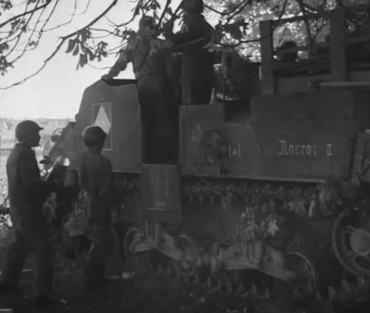
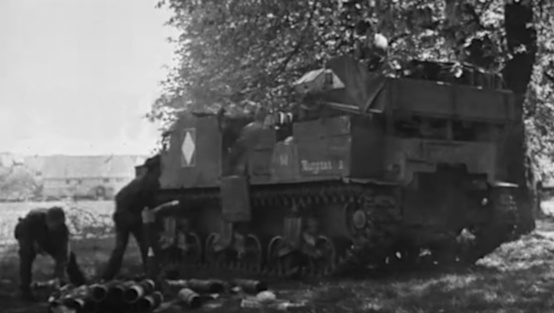
An interesting modification seen on a few M7s of the 62ème RAA is a folding door with hinges added to the left side of the hull. The intent appears to have been to facilitate the loading of ammunition. In addition, the Priest on the right can be seen to have had an enclosed platform placed above the engine deck for the storage of jerrycans and crew equipment. Unlike the 68ème RAA, the 62ème named its vehicles. Some were named after places related to the 1943 Tunisian campaign, such as "Pont du Fahs", "Ben Gardane" or "Zaghouan". Others adopted the names of French cities like "Dijon", "Besançon" or "Cherbourg". The two Priests seen above, "Rocroi II" and "Marignan II" of the 4ème Batterie, were named after historic French battles fought in 1643 and 1515 respectively. The stills come from a video entitled "Progression to Ravensburg" and dated 28 April 1945.

A small number of Shermans were employed as observation tanks in the artillery units of the French First Army. The 68ème Régiment d'Artillerie d'Afrique of the 1ère Division Blindée was equipped with a few early production M4A1(75)s. It is likely that these were US Army Italian or even Tunisian Campaign veteran Shermans provided to the French from the replacement
pools of the US 7th Army. Period documents suggest that there was only 1 such observation Sherman in the 1er Groupe, 2 in the 2ème Groupe and 3 in the 3ème Groupe. The three vehicles identified so far are seen fitted with M3 type bogies, and two are noted with Direct Vision. Above, is one of the DV examples, "Oran II", the observation tank of Capitaine Gerard Honsel of the 7ème Batterie. The particular type of taillight guard seen on "Oran II" was typical of M4A1s built by Lima Locomotive Works. Some of the earliest Limas have been noted to have had extra cable clamp (circled in red). Capitaine Honsel and "Oran II" are mentioned in a few of the 68ème RAA After Action Reports as they fought in Germany in 1945. The French POM code "MF 42341" painted on the hull can be cross referenced to the 7ème Batterie and, on the turret, the "A" within a blue square surrounded by 3 bars denotes the 3ème Groupe, which included the 7ème Batterie.

The 62ème Régiment d'Artillerie d'Afrique of the 5ème Division Blindée was equipped with M4A2(75)s and M4A1(75)s. The photo above shows "Bombarde", an M4A1(75) of the 62ème RAA crossing the river Lauter on a pontoon bridge near Scheibenhardt, in March 1945. The river marked the border between France and Germany. The extended fender seen on "Bombarde" suggests that it was remanufactured in the US. Photo courtesy of ECPAD, TERRE 10197-L48.
Part 3: M10 Gun Motor Carriages (Tank Destroyers)
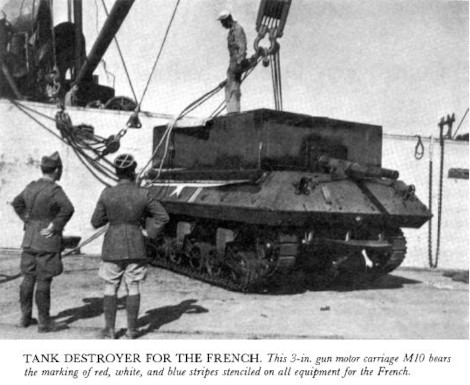
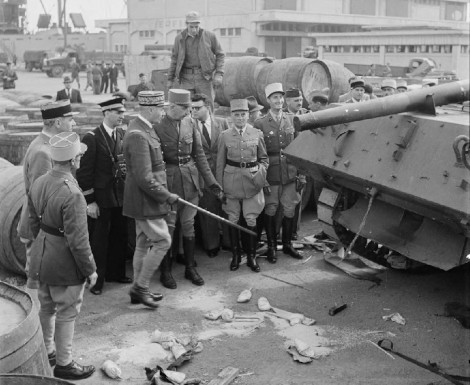
The M10 Tank Destroyer formed a very significant part of the French armored inventory. US Lend Lease documents give the official figure as 443 M10s. It is thought that the first shipment of M10s arrived with Special Convoy UGS 6 1/2 in April 1943. This included enough materiel "to equip 3 infantry divisions, 2 armored regiments, 4 tank destroyer battalions, 5 reconnaissance battalions, 14 40-mm antiaircraft battalions, 12 truck companies and air units representing more than 200 airplanes." The left side photo shows an M10 carrying a French flag on the hull side being unloaded in a port in North Africa. The right side photo shows French General Roger Leyer, First Adjutant-General in charge of the organization, giving technical details to General Henri Giraud, in the port of Alger on 17 April, 1943.
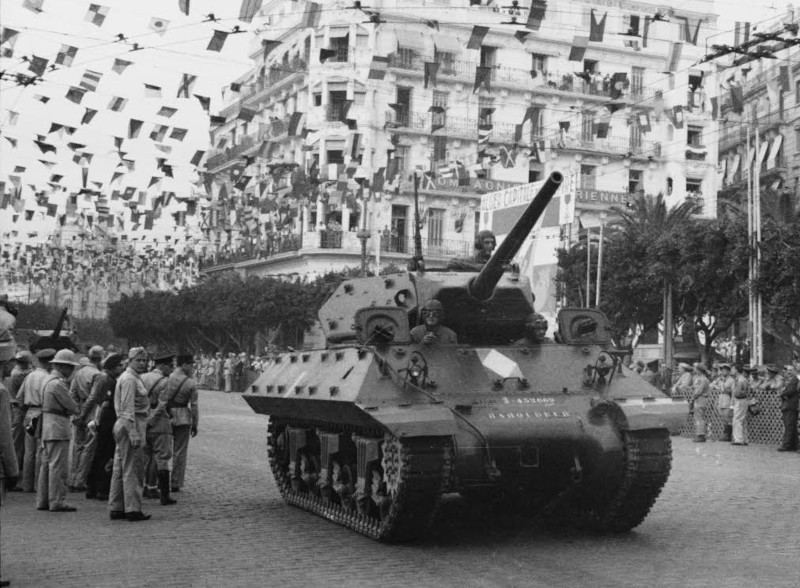
The 4 units described as "tank destroyer battalions" were formed from Régiments de Chasseurs d'Afrique, which were French Army of Africa cavalry units. These units were composed of 4 Escadrons, 1 being a light reconnaissance squadron and 3 being "heavy" squadrons, having 3 Pelotons of 4 tank destroyers, for a total of 36 M10 GMCs. A document from the "Service du Matériel" of Oran relates that the 9ème Régiment de Chasseurs d'Afrique was the first unit to receive 34 M10s on 25 April, 1943 (the Journal de Marche et Opération (After Action Report) of the 9ème RCA states that the regiment received the M10s on 17 April, 1943). The 7ème RCA received 32 M10s between 29 April and 3 May, 1943 and the missing ones on a later date. The 11ème RCA received its M10s starting on 3 May, 1943. The 8ème RCA received its M10s in May, 1943 as well. This photo shows "Baroudeur" of the 7ème RCA during a parade on the French "Bastille Day", 14 July, 1943 in Alger.
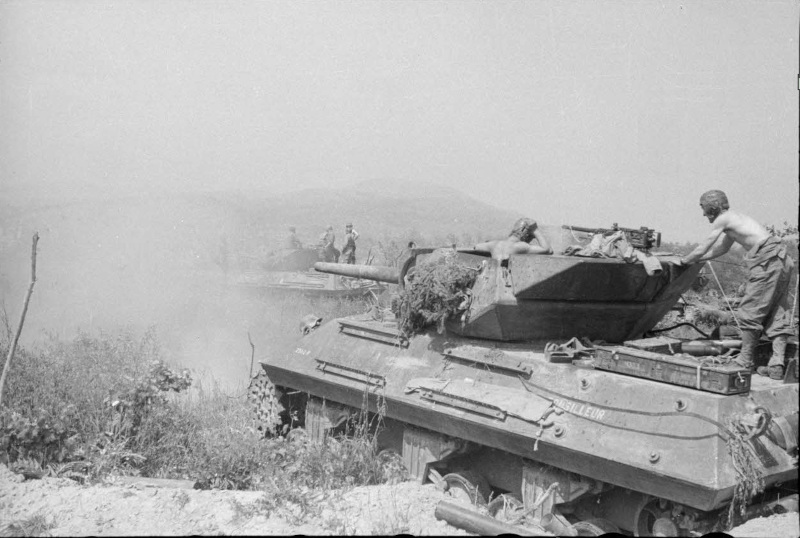
The 7ème RCA was created in April, 1943 with volunteers that came from "Chantiers de Jeunesse" (Vichy-created youth groups) in North Africa. Its commander, Lieutenant-Colonel Alphonse Van Hecke, was the Regional Commissioner of the Youth Groups in North Africa under authority of the Vichy government. On the night of 8-9 November 1942, Lt-Col Van Hecke along with most of the officers and men under his responsibility helped US units take the city of Algiers. As a result, only 2 French soldiers were killed in the area on that night. This early rally to the Allies led Lt-Col Van Hecke to be promoted as the commander of the 7ème RCA, a unit of "North-Africa youth groups" tradition. The 8ème RCA was stationed in French Sudan (now Mali), in French West Africa, which rallied to the Allies in late 1942. It was transferred to Oran in March, 1943. The 7ème and 8ème RCA were then designated to be part of the French expeditionary corps in Italy ("Corps Expéditionnaire Français en Italie") and left Oran in late December, 1943. The 2 units sailed to Naples and reached their combat positions in January, 1944. During 4 months, the 2 cavalry units held the line in difficult weather conditions, mainly serving as artillery. On 11 May, 1944, the 2 Regiments were engaged in "Operation Diadem", which successfully broke the German defenses on the Gustav line along the Garigliano river. By late June/early July, 1944 they had pushed the German army north of Rome, in Tuscany. They suffered a lot due to the mud, bad roads, mountainous terrain and fierce German resistance. For example, the 8ème RCA reported 21 TDs destroyed or damaged between 11 May and 4 June, 1944. The causes of damage were equally; anti-tank weapons, mines, and artillery. The 7ème RCA reported only 9 TDs as "available" on 28 June, 1944, just before it moved to Southern Italy for rest and refit. The photo above shows M10 "Bousilleur" of the 7ème RCA firing on the village of Castelforte, a village located on the Gustav line, on 12 May, 1944, the first day of "Operation Diadem".
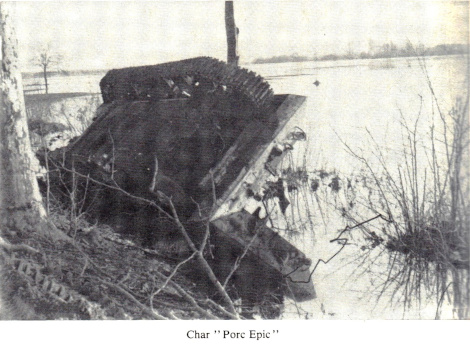
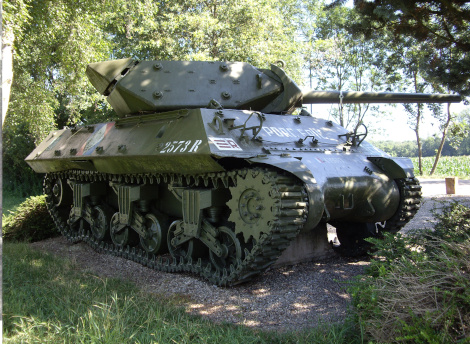
In August, 1944, the 2 units left Italy to participate to the landing in southern France. However, only part of the 7ème RCA landed in mid-August and the rest of the unit jointed 35 days later. The unit was engaged in combat operations, but it reported only 6 TDs as "available" on 15 September, and 14 on 28 October. On 12 January, 1945, the 2ème Escadron was down to 3 TDs, the 3ème Escadron to 8 and the 4ème Escadron to 3 for a total of 14. Period documents describe the difficulty in repairing the Tank Destroyers, getting supplies of replacement parts and maintaining them in combat condition. It was only on 23 March, 1945 that the 7ème RCA mentions the arrival of some new TDs that put it back at full strength. In any case, both the 7ème and 8ème RCA fought in the Vosges mountains, in Alsace and in Germany. Above shows "Porc-Epic" of the 8ème RCA, which was destroyed on 26 January, 1945 in Illhauesern and, which is still displayed at the same place.


The Régiment Blindé de Fusiliers Marins (RBFM) or Armored Naval Infantry Regiment was created in September 1943 as a Tank Destroyer unit with personnel from the French Marine. It was due to receive its vehicles in October or November 1943 as part of Phase IV of the French Army rearmament program set up on 15 August 1943. However, French correspondence in late 1943 indicates that they didn't know if the M10s assigned to this unit would be shipped directly from the USA or be provided by an American unit stationed in Morocco. Moreover, delays and disagreements between French and US authorities on the number of French divisions to equip, and the number of auxiliary and service units (engineers, logistics, maintenance, base units, depots etc.) necessary to support the front-line units provoked a revision of the rearmament program and a cutback in the materiel provided to equip combat units. Deliveries were suspended in November and December 1943 and a new program was set up on 23 January 1944. Another reason for the delay was the attempt by Allied Forces Headquarters to provide the French with "substitute weapons" in order to save shipping capacities. AFHQ proposed to allocate Half-Track based 75-mm M3 GMCs that were readily available in North African stocks, instead of M10s that had to be shipped from the USA. The French refused, arguing that the M3 GMC was of inferior quality and that the disparity of the matériel would complicate logistics and maintenance. It was only in March 1944 that the Tank Destroyers, etc. needed by the RBFM were assigned for shipping and delivery from the USA. These would not be available in time, so the 11ème Régiment de Chasseurs d'Afrique, which had received 36 M10s in May 1943, was ordered to provide them to the RBFM on 8 April 1944, just a few days before the unit left Morocco for the UK as part of the 2ème DB.

The M10s that the 11ème RCA received in May 1943 and provided to the RBFM were early 1943 production. For instance, "Flibustier" of the 3ème Escadron was Serial Number 1005, indicating that it was manufactured in February 1943. We know that because its dataplate was removed by wounded crew member, Guy Blanche, after the tank destroyer was hit by a Panzerfaust near Royan on 15 April 1945. The dataplate was on display at the "Musée de la poche de Royan" before it closed. Period photos show M10s with the so-called "small turret" with the upper rear sloped inwards, wedge-shaped counterweights, armor bosses on the front and sides of the hull and a stirrup-shaped gun cradle on the rear deck. Probably the most well-known M10 of the RBFM was "Siroco" of the 4ème Escadron, commanded by Maître Torpilleur Jean Krokenberger. He and his crew were credited with a record 9 tanks and 9 vehicles and guns destroyed in combat, according to the division citation he received in April 1945.


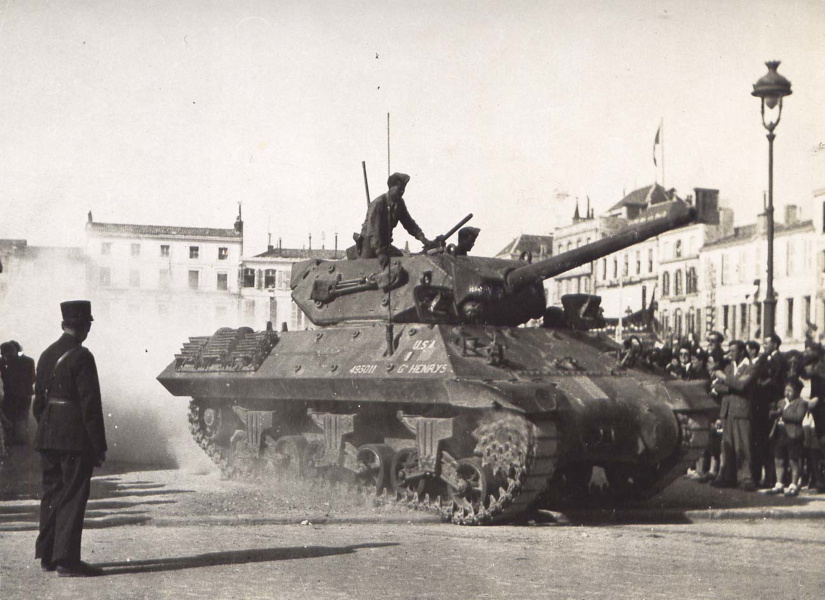
On 27 April, the 2ème Escadron was listed with 11 TDs, the 3ème with 7 and the 4ème with 10.The 1er RSM was engaged in combat again on 30 April, 1945 as part of "Opération Jupiter", the liberation of Oléron island, north of Royan. It was not involved directly in assaulting the island, but was positioned near Thairé and Ciré d'Aunis (south of the pocket of La Rochelle) to shell the German positions and to prevent them from attacking from the north. On the 2nd of May, it supported the French infantry in taking the village of Aigrefeuille, north of Ciré d'Aunis, and the hamlets of Yves and Le Marouillet along the Atlantic coast. The 1er RSM was then sent to La Rochelle for the purpose of maintaining order in the city after the German surrender. The photo above was taken on Place de Verdun in La Rochelle on VE-Day, 8 May, 1945 during the Victory parade. The few available pictures show M10s carrying names of illustrious Spahi-related soldiers like "Général Henrys", "Général Jouinot-Gambetta" or "Sous-Lieutenant De Waziers". Another picture showing Général de Vernejoul, commander of the French Forces in Germany inspecting the 1er RSM in Germany on 29 November, 1945 shows vehicles with names of Spahi-related battles like "Uskub" or "Salonique". In late May, 1945, the regiment moved to Lahr as part of the French Forces in Germany. A document dated 29 May, 1945 states that the 36 Tank Destroyers are worn out, 2 of the Escadrons had unusable tracks which would prevent the TDs from moving.
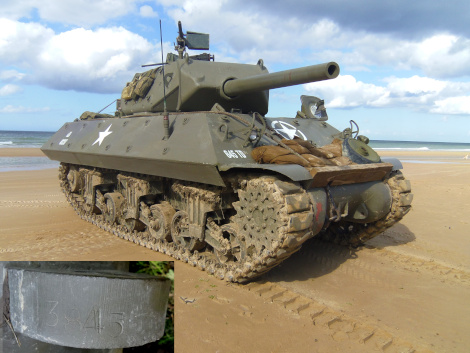
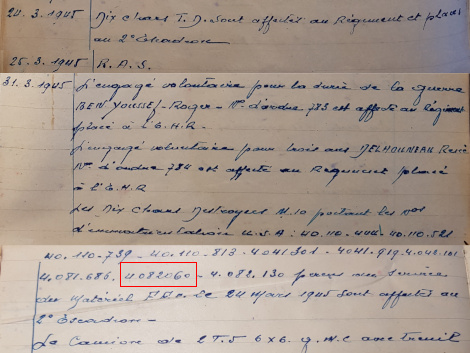
This M10 is Serial Number 3845, a vehicle built by Fisher in July, 1943. The corresponding USA number is 4082060. It is currently in a private collection in France and has been restored to running condition. The After Action Report of the 1er Régiment de Spahis Marocains lists USA 4082060 as having been allocated to the 2ème Escadron, 1er RSM on 24 March, 1945. It also lists the Registration Numbers of 15 more M10s received on 24 March and 4 April, 1945 and it shows that these vehicles were produced between December 1942 and September 1943. At least one of them has been identified with the 818th Tank Destroyer Battalion in the UK, in March 1944. This American TD Battalion was converted to M36s in February 1945 and probably transferred some of its surplus M10s to the French after conversion.
The list of French Sherman tanks, M10s, M7s and TRVs during WW2
HOME

The first use of Sherman tanks by a French unit appears to have been with what the British termed, the "Fighting French Tank Company.” Originally known as the 1ère Compagnie Autonome de Chars de Combat (1ère CACC), it was merged with the French Army Corps Reconnaissance Group (GRCA), and was known as the "Free French Flying Column.” As part of the British Eighth Army, it fought at El-Alamein, and entered Tunisia in February, 1943. The tank company was then attached to "Force L (Leclerc)," and later became the 1st Company of the newly organized 501ème Régiment de Chars de Combat, “2ème Division Blindée.” In any case, the Eighth Army Tank State for April 12, 1943 is shown above, and lists "2 Shermans" along with 12 Crusaders in the "Fighting French Tank Coy."


It is not clear if the "Fighting French Tank Company” ever used its Shermans in combat. However, a few interesting photos taken by 1ère CACC Officers Jacques Blasquez and Alexandre Kremetchousky suggest that the 2 generic Shermans listed in the Eighth Army Tank State were early production M4A1s. By their appearance, it is likely that they were part of the “Emergency Shipment” from the US, which arrived in Egypt in September, 1942. The one in the left side photo was nicknamed "Chieftain." The tank’s paint was heavily weathered, but the name can just be seen painted on the hull side in a manner noted on Shermans of the 3rd Battalion, Royal Tank Regiment. An account by crew member Michel Boulanger provides some details. Boulanger was the radio operator/loader on Capitaine Daniel Divry's (the 1ère CACC commanding officer) Crusader. Divry's tank was put out of action on March 6, 1943, near the Matmata Hills, in southern Tunisia. Shortly after the Battle of the Mareth Line in late March, 1943, the British delivered a Sherman tank to replace Divry's Crusader. Boulanger specifies that it was "equipped with a radial engine.” In the left side photo, Général Philippe Leclerc appears with his trademark cane, along with Capitaine Divry and other French Officers. The M4A1 in the photo on the right can be seen as T-144970. We have recorded a listing for this Sherman as in the 22nd Armoured Brigade Workshops (in Egypt), December, 1942. It is assumed that these photos were taken in the Spring of 1943, and that the French had not yet had the time to repaint the tanks with their own tactical markings. After the Allied victory in Tunisia in early May, the units of "Force L" moved to Sabratha in Libya, and later to Morocco, where they were organized as the “2ème Division Blindée.” Both photos from the Alexandre Krementchousky Collection, courtesy of Musée du Général Leclerc de Hauteclocque et de la Libération de Paris - Musée Jean Moulin.

The Allies invaded Northwest
Africa on November 8, 1942. It was hoped that Vichy French Forces in
the
colonies of Algeria and Morocco would not oppose the
“Operation Torch”
landings, and instead would join the Allies in the fight against the
Axis.
Unfortunately, this did not occur and British and US Forces had to
fight their
way ashore. The French capitulated on November 10, and following
delicate and
occasionally embarrassing political negotiations, agreed to join the
Allies.
French General Henri Giraud played an important role during and after
the
Casablanca Conference in January 1943. As a consequence, the US agreed
to
supply materiel to the so called “Free French in North
Africa,” which helped to
establish and train several Divisions, including three Armored
Divisions. The
"International Aid Statistics" Report indicates that the French
received 656 "Tanks, Medium and Heavy" through Lend-Lease. In fact
all of them were Sherman Medium Tanks, and France was the third largest
recipient of the Sherman, after the British Empire and the USSR.

Deliveries of medium tanks under the official Lend Lease program occurred in 1943 and 1944. The 656 Shermans allocated to the Free French consisted of 274 new production M4A4s, 362 new production M4A2s and 20 remanufactured M4A2s. It is thought that all of these were shipped to Northwest Africa, except for the 20 M4A2s allocated in October 1944. Most likely, these came in through Marseille, France sometime in early 1945. (Legend : A = allocated; M = manufactured; S = shipped from the factory; F = floated)

The M4A4s and M4A2s were delivered to the ports of Algiers (Algeria) and Casablanca (Morocco) in 1943. The French formed three Armored Divisions, each equipped with 165 Shermans. The US required that homogeneous Armored Divisions be created. Thus, the 2ème Division Blindée was entirely outfitted with M4A2s. The 1ère Division Blindée was intended to be equipped only with M4A2s, and the 5ème Division Blindée exclusively with M4A4s. However, the original tank allocation of the 1ère and 5ème Divisions was not homogenous and they both started training duties with 110 M4A4s and 55 M4A2s. Despite multiple American requests for standardization, the French refused to retrain the troops on other engine types, or to exchange Regiments between Armored Divisions, as it was felt such transfers would affect unit cohesion and morale. In the end, M4A4s were allocated to the 2ème Régiment de Chasseurs d'Afrique and 2ème Régiment de Cuirassiers (1ère Division Blindée) and to the 1er Régiment de Chasseurs d'Afrique and 1er Régiment de Cuirassiers (5ème Division Blindée). The 110 M4A2s were evenly allocated to the 5ème Régiment de Chasseurs d'Afrique (1ère Division Blindée) and the 6ème Régiment de Chasseurs d'Afrique (5ère Division Blindée). The photo above shows French General Henri Giraud standing in front of an M4A4 delivered to the port of Algiers on 17 April, 1943. It has the little French flag shipping stencil on the side, and still carries its "On Vehicle Materiel" (OVM) box on the engine deck. Photo courtesy of ECPAD, TERRE 34-618.
Part 1: The 2ème Division Blindée


362 diesel engined M4A2(75)s were allocated to the “French in North Africa” between May and July, 1943. Photographic evidence suggests that most of those distributed to the 2ème Division Blindée were manufactured in 1943, but some 1942 production units are also seen in the mix. For instance, the photo above left shows "Perthus" of the 12ème Régiment de Chasseurs d'Afrique, with Direct Vision (1), and the M34 Gun Mount with the narrow rotor shield (2), features typical of 1942 Shermans. “Ile de France,” another M4A2 of the 12ème RCA is shown on the right. The sharp nosed “Mary Ann” differential housing (3) was introduced into production at Fisher Body in July 1943, and it is thought that “Ile de France” would have been one of the M4A2s allocated to the French during that same month. For an idea of the timeline, the 12ème RCA is reported to have received its M4A2s in Morocco between 26 and 28 September 1943. Note the wider rotor shield of the M34A1 gun mount (4). Both of these tanks appear to have received a few “in the field” modifications, including the turret appliqué armor patch (5). The visible gap in the patch on “Ile de France” suggests that it was a case of an unnecessary application (see below for further details). These tanks were photographed landing on Utah Beach on August 1st or August 2, 1944, and each can be seen with a “Somua” plate affixed to the front, a souvenir of the old Somua S-35 tanks the Regiment had in North Africa.


The French 2ème Division Blindée was chosen to take part in the Normandy Campaign, and shipped out of North Africa with its 165 M4A2s on April 11, 1944. It landed in the United Kingdom 11 days later, where it continued to train. The Division was the subject of a good deal of Press coverage when it landed in Normandy in early August, 1944, as it was the first major French unit to reenter France. The US Ordnance Department directed that US Army Shermans located in the UK receive a number of upgrade modifications prior to the D-Day Invasion of Europe. As the 2eme DB was attached to the US Third Army, its tanks were considered subject to the directive, and the Division was provided with quantities of the various modification kits. However, it would appear that French Maintenance units were overwhelmed by the number of modifications, and did not have the time or manpower to apply them “by the book.” For instance, period photos and a few surviving examples, show that the hull appliqué plates that were part of the "Quick Fix" modification kit were merely tack welded on, a technique that would been rejected by US Army inspectors. The image on the left is from newsreel footage shot in North Dalton, UK, in July, 1944, and shows French mechanics welding an appliqué plate on "Arcis sur Aube," an M4A2 of the 501ème Régiment de Chars de Combat. The right side photo shows the non continuous weld beads on "Massaoua," an M4A2 destroyed on August 15, 1944 in Ecouché, Normandy. A few of the surviving 2eme DB monument Shermans on display in France, like "Massaoua," are missing their applique plates, most likely due to the inadequacy of the original tack welding method.

One of the modifications mandated for installation on US Shermans in the UK was Blitz Item No. 57, "Increase thickness of Turret Armor in Region of Traversing Gear." There were a couple of scooped out "thin spots" on the right front side of the turret's interior wall that provided clearance for the crew to work the traversing mechanism. It was reported that the enemy aimed for these thin spots, so an exterior patch kit was produced to correct this defect. In the meantime, the D50878 turret mold was altered by providing a "cast in thickened cheek" which eliminated the need for the welded on turret patch modification. Ordnance engineers considered the pistol port to be a weak spot on the Sherman's turret, and made the unfortunate decision to eliminate it from the revised casting. The new turret castings entered the production pipeline in the Summer of 1943, and it is obvious from period photos and surviving examples that the French received a few M4A2s with "cast in thickened cheek/no pistol port" turrets. In any case, an interesting anomaly seen on a handful of 2eme DB Shermans is the unnecessary application of the welded on turret patch to the revised turrets (see the 75mm turret page for further details). "Valois," "Massaoua" and "Chemin des Dames" are historical examples featuring unnecessarily applied turret patches. The cast, two piece applique sections were not made to fit the revised turret, and Massaoua (pictured above) shows a particularly poor fit. Lack of direction from US Ordnance personnel, and/or simply a language barrier misunderstanding were the likely culprits in the case of the unneeded turret appliqué.

An informal modification seen on some but not all of the Shermans of the 2eme DB is the installation of a large stowage box on the upper rear hull plate (1). A few surviving examples can be seen with a round weld scar (2) denoting the original position of the track adjusting wrench. The wrench holder was removed so that the stowage box could lie flat. In some cases, the tool fittings on the upper rear hull plate were repositioned below the new stowage box (3) as seen in the left side photo. In other cases, it is thought that crews stored the tools inside the (locked) stowage box, as such implements were prime targets for theft. On some French Shermans, the crews fabricated holders for jerrycans. Often the fittings were simple metal bars bent and welded together. However, a few surviving examples have fittings that were obviously made from recycled parts of the original sand shields - cut, folded and screwed on to the upper rear plate ends (4).

The two barred Croix de Lorraine (Cross of Lorraine) was adopted as the symbol of the Free French Forces who chose to continue to resist the Nazis after the Fall of France in June, 1940. The unit symbol chosen by the 2ème Division Blindée consisted of a blue circle containing a map outline of the country of France over which was superimposed the Cross of Lorraine. General Leclerc created this symbol (1) and, on 19 March, 1944, in the "Ordre Général n° 15", ordered it to be painted on every vehicle of the 2eme DB. Another of the modifications mandated for installation on US Shermans in the UK before D-Day was the "2 inch Smoke Mortar." The mortar was to be installed inside at the left front of the turret through a hole drilled or burned into the armor. It would appear that some French units chose not to install the mortar "by the book," possibly because they lacked the time or the proper tools. A few M4A2s of the 501ème Régiment de Chars de Combat are seen with the smoke mortar affixed to the exterior of the turret on the right side as shown above (2) on "Friedland," photographed in Paris on August 25, 1944, the day the German Garrison surrendered the French Capital. "Friedland" can also be seen with a stowage box (3) on the rear of the turret which, along with the aforementioned installation of the large stowage box on the upper rear hull plate, was a common practice in the 2ème Division Blindée. Collection Benjamin Josset via Laurent Fournier.

The 2ème Division Blindée employed 3 radial-engined Sherman tanks in
each of its 3 artillery groups. It is thought that these were assigned
in order to fit the standard US Table of Organization and Equipment
(T/O&E), which allocated 3 M4 or M4A1 medium tanks to the HQ of each
artillery regiment equipped with radial engined M7 Priests. The
"Journal de Marche et Opérations" (French equivalent of "After Action
Report") or JMO of the 1/3ème Régiment d'Artillerie Coloniale (1/3è RAC)
and of the 1/64ème Régiment d'Artillerie de Division Blindée (1/64è
RADB) state that these units received 3 Shermans each as observation
tanks on 26 July 1944, while in the UK. It is thought that the
1er Groupe, 40ème Régiment d'Artillerie Nord Africain received its 3
radial-engined Shermans at the same time. The
photo above shows "Cyrano de Bergerac," which belonged to the 1/40ème
RANA. This unit can be identified as an M4(75) (as opposed to M4A2(75))
by the cut-out configuration of the upper rear hull plate (arrow).
Radial engine Shermans (M4s and M4A1s) carried a pair of external air
cleaners, and the right-side unit (1) is just visible in the photo. The 2
M4(75)s and single M4A1(75) identified as with the HQ, 1er Groupe du
40ème RANA are seen in period photos, at first in early August 1944 with
the lower part of the wading trunk still installed on the rear section
of the hull. Later, a portion of the trunk appears to have been
installed on the turret bustle as shown in the inset above. Thus, it
would seem that the wading trunks were recycled for use as stowage
boxes.

The French were not issued any 105 Shermans as official Lend Lease, but since their units served under US Army command, additional equipment (including tanks) was provided from US Army stocks. The 2ème DB was an early recipient of the type, and received a few M4(105)s in mid-July 1944 while in the UK. The photo above is dated August 1, 1944 and symbolizes the long anticipated return to "la terre sacrée de France." “Moghrane” of the 2ème Escadron, 12ème RCA (Régiment de Chasseurs d’Afrique) is seen here coming ashore on Utah Beach. In general, French units painted out the USA Numbers, and replaced them with their own system of "matricule" numbers. (Our research suggests that these first M4(105)s were assigned matricule numbers in the 90 xxx range.) In any case, although a number of French tactical markings are visible on “Moghrane”, "USA 30103764" had not yet been over painted. The USA Number indicates that “Moghrane” was an April 1944 production M4(105), most likely one of the first 210 shipped to the UK in the months before D-Day. The most obvious feature of M4(105)s produced from the start of production in February through April 1944 is the commander's split hatch (arrow). It is thought that all 105 Shermans, both M4 and M4A3, had the commander's all round vision cupola factory installed starting in May, 1944.

The JMO of the 12ème Régiment de Chasseurs d'Afrique states that around 17 July 1944 while in the UK, the unit received 6 M4(105) Shermans. These were distributed two each to the 2ème, 3ème and 4ème Escadrons. After several weeks in combat, officers of the 12ème RCA reported that they found it "inutile" (unuseful) to have howitzer Shermans in their Escadrons and suggested that it would be much better if they were used to set up a 4th battery in the 1st Group of the 40ème RANA, the artillery unit attached to the 12ème RCA. At full strength, the other 3 batteries would have been composed of 6 M7s each. The JMO reports that, on 3 September 1944, the 12ème RCA exchanged its 5 remaining M4(105)s ("Pic d'Anie" had been destroyed on 11 August) for the 3 75mm radial Shermans of the 1/40ème RANA. One of these, an M4(75) named "Cyrano de Bergerac" as seen in a previous caption, was transferred to the 1er Escadron, while the M4(75) "25 août 1944" and M4A1(75) "Brigadier Escourrou" were transferred to the 4ème Escadron. The documents reproduced here are from the archives of the 12ème RCA and mention the transfer of the tanks.

While Ford-engined Shermans (M4A3s) were generally reserved for US Army use, the combat debut of the M4A3(76) in Northwest Europe may well have been with the 2ème Division Blindée. As mentioned above, the Division was attached to the US Third Army, and received about 25 of the first M4A3(76)s as replacements in mid-August to make up for M4A2 losses suffered in Normandy. For example, the 12ème RCA received 4 M4A3(76) on 15 August, 1944. Our research suggests that these units were assigned Matricule numbers in the 95 xxx - 96 xxx range. "Champagne," Number 55, served with the 3rd Squadron of the 12ème Régiment de Chasseurs d’Afrique. On August 25, 1944, during the battle for Paris, her crew was credited with firing the "kill shot" that knocked out a Panther in the Place de la Concorde. In the crew snapshot above, one can see that Champagne was another French Sherman that "still" had the USA Number painted on. "3099828 S" was the 67th M4A3(76) made by Chrysler, and would have been accepted in April, 1944. (The "S" often seen at the end of USA Numbers is frequently mistaken for a "5," but it signifies that the vehicle was equipped with a Radio Interference Suppression System.). "Champagne" was knocked out on September 13, 1944 in Ville-sur-Illon, near Dompaire and is on display there as a monument to this day. Other French units that used M4A3(76)s include the 501ème Régiment de Chars de Combat, 12ème Régiment de Cuirassiers and 1er Régiment de Marche de Spahis Marocains. Photo courtesy of Musée du Général Leclerc de Hauteclocque et de la Libération de Paris - Musée Jean Moulin.

The 2ème Division Blindée suffered heavy tank losses during its first days in combat in August 1944, and received quite a few replacement Shermans from Third Army reserves. Included among them were about 20 M4A3(75)Ws. As with the M4A3(76)s, the 2eme DB appears to have been the first combat unit to have been issued this model. The photo above was taken in Paris, near the Palais-Bourbon on August 25, 1944. The trailing Sherman can be seen as one of the new M4A3(75)Ws, named "Saint-Vaast," Matricule Number 95072. The lead tank,"Cherbourg," was also a replacement. It was a Baldwin built M4, USA 3022839, with a Matricule Number of 95073 (one higher than "Saint-Vaast's"). These tanks served with the 2ème Escadron, 12ème Régiment de Cuirassiers. The photo suggests that there was no conscious effort to resupply the unit with only M4A3s or only M4s/M4A1s. More likely these tanks were simply on hand and ready for issue in the replacement pool. The logistics of the units of the 2eme DB would have become extremely complicated with the issue of replacements. Not only did they have to service their original diesel M4A2s, but now had to deal with two different types of gasoline engines - the Continental Radial and the Ford V8. In any case, the M4, "Cherbourg" was put out of action perhaps minutes after this photo was taken, during the attack on the Palais-Bourbon. "Saint-Vaast" was reported destroyed north of Paris in Le Bourget on August 27, 1944. Photo courtesy of Arax Djololian, Musée Carnavalet.

Another M4A3(75)W received as a replacement by the 12ème Régiment de Cuirassiers was "Bourg la Reine." Its original Matricule number can just be seen in the period photo above as 96012 (circled). The tank was destroyed on the western outskirts of Phalsbourg, France on November 21, 1944. “Bourg La Reine” has been preserved as a monument in Phalsbourg, and we have recorded its Serial Number as 49709, indicating that it was manufactured by Fisher Body in May 1944. Other French units that were equipped with some M4A3(75)Ws include the 501ème Régiment de Chars de Combat, 12ème Régiment de Chasseurs d’Afrique and 1er Régiment de Marche de Spahis Marocains.

A few M4A3(105) Shermans appear to have been received as replacements in Fall 1944 to make up for M4(105) losses. All of the M4A3(105)s we have been able to identify served with the 12ème Régiment de Cuirassiers. One of them was St. Denis III, which replaced St. Denis II, an M4(105) destroyed on 30 November, 1944 in Alsace. The two other ones were "Pont de Kehl," which replaced the M4 105mm "Cherbourg", destroyed in Strasbourg on 23 November, 1944, and "Oran". In period photos, an M4A3(105) can be distinguished from an M4(105) by the engine deck door stops mounted on each side of the hull in the rear, as shown circled in red above. Photo taken at the ERGMEB Gien in 1945.


M4A1(75)s also served with the 2ème Division Blindée. A study of period photos shows that each of the 3 artillery groups received 3 radial-engined "Sherman Observatoire" when the 2ème DB was stationed in the UK, to fit with the standard US T/O&E. At least 2 M4A1s have been identified with the 40ème RANA and the 3ème RAC, and one in the 64ème RADB. On November 27, 1944, the 2ème Division Blindée was transferred from the Third Army (Twelfth Army Group) to the Seventh Army (Sixth Army Group). As a result of a significant shortage of combat vehicles, a few more M4A1(75)s were delivered in late 1944. A US Army report indicates that 9 M4A1(75)s were on hand with the 2ème DB in Alsace as of January 10, 1945. Supplies of M4A1s to 2ème DB units continued into late winter and spring, 1945, as more replacement tanks were made available from Sixth Army Group reserves. The photo above left shows "Saint Chamond II" of the 12ème Régiment de Cuirassiers. This M4A1 displays early features such as the M34 Gun Mount with the narrow type of rotor shield (1) and the "aircraft type cowl fasteners," used to secure sand shields before the introduction of the standard design in mid 1943 (2). The Direct Vision ports of the drivers' hatches have been covered over by a field application of armor plates (3). "Verdun IV" (right) was another M4A1(75) of the 12ème Régiment de Cuirassiers. The M3 type suspension (4) suggests that this early production unit may have served with the US Army during its first campaign in Northwest Africa, and in the subsequent campaigns in Sicily and Italy. US Armored units assigned to the 7th Army for the Invasion of Southern France (Operation Dragoon, August 1944) were detached from the US 5th Army in Italy and came ashore with many such early Shermans. Some of these tanks had received a number of upgrades at workshops in Northwest Africa and Italy, as Modification Kits were shipped to the theater starting in the Fall of 1943. "Verdun IV" can be seen with the "Quick Fix" modification as represented by the appliqué plates (5) on the hull sides, as well as the "Increase Thickness in Area of Traversing Mechanism" (6) modification to the turret. It is thought that a number of these early M4A1s were transferred to the French when they were withdrawn from US service after 7th Army armored units were re-equipped with later model Shermans. Both photos courtesy of Musée du Général Leclerc de Hauteclocque et de la Libération de Paris - Musée Jean Moulin.


In the final weeks of the War in Europe, French armored forces received additional supplies of M4A1(75)s, but unlike the ones described in the previous caption, these had been remanufactured in the US, before shipment overseas. The photo above left, taken around April 21st, 1945, is part of a series that shows rail cars transporting Sherman tanks to the 2ème Division Blindée just before it began its final push into southwest Germany. Most of the tanks seen in this series are remanufactured M4A1(75)s. Some are noted with the E9 suspension, a modification that only became available in early 1945. "Aunis III" (above, right) was photographed returning from Germany shortly after VE Day, May 8, 1945. The riveted lower hull (1) identifies this tank as a Pressed Steel Car M4A1 produced in May, 1943 or earlier. Starting in late 1944, remanufactured Shermans received extended fenders (2) to accommodate extended end connectors, along with the commander's all round vision cupola (3). If needed, they were installed with the "Quick Fix" modification as represented by the appliqué plates (4) on the hull sides, as well as the "Increase Thickness" (5) modification to the turret. A couple of other mods that were installed if not already present included positive hatch lock mechanisms (6) and periscope guards (7). Left side photo courtesy of Musée du Général Leclerc de Hauteclocque et de la Libération de Paris - Musée Jean Moulin, right side photo courtesy of ECPAD.

Only a
handful M4A1(75)s with E9 suspension are seen in period photos, all of
which show them in possession of the French Army. Oddly, none are seen
with the extended end connectors (EECs) installed. (At the end of the war in Europe, the US Army
directed that EECs be removed and collected up so that they could be
passed on to the "active theater" (the Pacific)). The photo above is
said to have been taken in
Berchtesgaden, and
shows a remanufactured M4A1 named “Petitmont” of
the
2nd Company, 501ème
Régiment de Chars de Combat. According to Claude
Hoffman, the tank’s driver, whose account is included in a
book written by the Company’s Commander, Capitaine de
Witasse,
"Petitmont" was received as a
replacement on 27 April 1945 in the city of Brumath, Alsace. Starting the next day, the 501 RCC began a 400
mile dash through Bade-Wurtenberg and Bavaria that ended on the evening
of May 4 when the unit along with other elements of the
2ème Division
Blindée entered the Nazi resort town of
Berchtesgaden. In this view, the “hole” (1) in the
center of the drive sprocket, indicates that the tank was installed
with the E9 modification, which extended the suspension out from the
hull by 4.5 inches so that EECs could be installed on both ends of the
tracks. The mod also provided for extended fenders with supports. These
have been removed from
“Petitmont,”
although the little “bumps” (2) of the fender
supports remain. The
commander’s vision cupola (3), and the armored periscope
cover (4)
were other items that were added when this tank was
remanufactured. Finally,
“Petitmont” also features
the M34 gun mount with "wing piece" welded to
the rotor shield (5). This modification was intended to be used in 1944
in order to retrofit coaxial telescopic sights to US Army Shermans in
the UK before D-Day that were equipped with the original M34 gun
mounts. The kits could not be produced in time, so entire M34A1 gun
mount replacements were sent instead. In the end, the kits were used on
remanufactured Shermans starting around 1945. For that reason, they are
as rare as E9 in WW II overseas photos.

The
image above is part of the same April, 1945 "rail car" series as the
one shown previously. In a some of the photos, a few (105)HVSS
Shermans of
indeterminate type (1)
can be seen mixed in with the remanufactured M4A1(75)s. The On Vehicle
Materiel
boxes (2) on the engine decks indicate that these tanks had not yet
been
processed and made “Ready for Issue.” The number of
M4 and M4A3(105)HVSS Shermans
supplied to the 2ème DB is not known, and at present we have
not come across
any “combat shots.” As for the other French Armored
Divisions (1ère and 5ème
Divisions Blindée), it is thought that they were not
equipped with any 105
Shermans whatsoever until April, 1945. Documents from the French
Archives in
Vincennes report that 18 "M4A3 105mm" were listed as
“authorized” to
each Division starting in late January, 1945, but it is only from 29
April
through 5 May, 1945 that they become listed as “on
hand.” However, we
would observe that period photos from the Summer of 1945 suggest that
most of these tanks were M4(105)HVSS, although "La Marne III"
[photo’d during a parade in Paris on 18 June, 1945] can be
seen clearly as an M4A3(105)HVSS. Photo
courtesy of Musée
du Général Leclerc de Hauteclocque et de la
Libération de Paris - Musée Jean Moulin.

Due to its attachment to the US Army throughout the campaign in Europe, the 2ème Division Blindée received replacements made up of just about every type of Sherman used overseas by US Armored Forces. All of the M4(75)s produced by the Chrysler Corporation, along with perhaps the last 300 ALCO M4s, were somewhat atypical in that their hulls were not of all welded construction. Instead the rear two/thirds of a welded hull was joined to a cast front end. The US Army did not make an official distinction between this construct and the all welded models – both were designated “M4.” The British did acknowledge the difference, and labeled them "Hybrids." In present Sherman circles, for the sake of clarity, they are often referred to as "M4 Composites." In any case, there are a few period photos showing M4 Composites in service with the 2ème Division Blindée. In the book “La 2ème DB" (Editions Heimdal), author Alain Eymard describes "Wissembourg" as having been assigned to the 12ème Régiment de Cuirassiers on November 30, 1944. The photo above is one of a series of crew snapshots taken in Torcheville, Lorraine in February, 1945. The arrows indicate where the cast front end was welded to the rest of the hull. "Wissembourg" can be seen with the extended fenders (we’ve circled a couple of the fender supports) typical of many remanufactured Shermans. The machine gun stowage fittings (1) on the turret bustle would have been another modification added during remanufacture. Unlike the M4A1s in the rail car series, this tank does not have the commander’s vision cupola, so perhaps it was rebuilt a little earlier, before the cupolas became available to the remanufacturer? There are several period photos of another M4 Composite named "Harstadt II.” On the Chars français website, it is noted that it was assigned at an unknown date to the 501ème Régiment de Chars de Combat. Photo courtesy of Caporal Gimenez via Alain Eymard.


Another uncommon type of Sherman was employed by the 2ème DB. Period photos show that at least two former Duplex Drive M4A1s, "Beauvaisis III" and "Anjou II", both served in the 12ème Régiment de Cuirassiers. As with many used DDs, these tanks were stripped of most of their fittings so that they could serve more efficiently as regular gun tanks. It seems likely that they were drawn by the 2ème DB from the replacement pool of the 7th Army. The photo on the left was taken on May 19, 1945, during a victory parade at Klosterlechfeld Airfield near Landsberg, Germany. The M4A1 in the foreground can be identified as a stripped down DD by the welds on the differential housing (circled in red) and the unusual shape of the front fenders. "Paint archeology" (inset) has determined that the tank in the right side photo is the original "Beauvaisis III" of the 2ème Peloton, 1er Escadron of the 12ème RCA. Note the "DD welds" on the differential housing (1), and the front fenders (2) with DD fittings. The head lights on DDs were extended up about 14 inches in order for the light beams to clear the floatation screen when it was in the lowered position. As a consequence, the head light guards (3) were extended up, and were much higher than the standard guards, as seen here. "Beauvaisis III" is preserved in the MM Park Collection near Strasbourg, but we would point out that it no longer has a turret with DD fittings. Left side photo courtesy of the Musée du Général Leclerc de Hauteclocque et de la Libération de Paris - Musée Jean Moulin.




In 1945, a few M4(75)s from the US reserve pool were delivered to the 2ème Division Blindée. Among them was "N. D. [Notre Dame] de Lorette II" of the 501ème Régiment de Chars de Combat. The unusual "appliqué plates" seen in the top left and top right photos suggest that this particular Sherman was a former T3 Mine Flail. The "plates" which can be seen mounted in the same location on both sides, actually held the flail boom. US Ordnance documents note that 41 new production Pressed Steel Car M4s were converted to T3s. These were essentially copies of the British "Scorpion" design. The first batch of 30 were converted in April, 1943 and a number of them were shipped to Northwest Africa soon thereafter. The 6617th Mine Clearing Company (Provisional) employed 12 of the T3s in support of the 1st Armored Division during the breakout from Anzio in May, 1944. The T3s proved ineffective, and were removed from service. It is thought that many of them were stripped of their flail fittings, and reconfigured as regular gun tanks, available as replacement tanks in the reserve pool. "N. D. de Lorette II" is seen in the top left photo between 8 and 11 May, 1945 in Bavaria, probably near Berchtesgaden. The bottom left photo shows the same tank at a parade in Paris on 18 June, 1945. For context, the last photo shows one of the T3 Mine Flails during trials at the 5th Army Engineer Training Center in Algeria in the Summer of 1943. First photo courtesy of Musée de la Libération de Paris - musée du Général Leclerc - musée Jean Moulin


US Lend Lease documents have it that the French received a significant number of M7 Priests - 283. These appear to have been deployed with their armored divisions. For instance, three artillery "groups" were part of the 2ème Division Blindée. The 1er Groupe, 40ème Régiment d'Artillerie Nord Africain (1/40e RANA) was part of the Groupement Tactique Langlade (GTL). The 11ème Groupe Blindé, 64ème Régiment d'Artillerie de Division Blindée (11/64e RADB) belonged to the Groupement Tactique Warabiot or GTV. The 1er Groupe, 3ème Régiment d'Artillerie Coloniale (1/3e RAC) was part of the Groupement Tactique Dio (GTD). Each artillery group was composed of 3 batteries, each one having 2 sections of 3 artillery pieces, for a total of 18 M7 Priests. The "Journal de Marche et Opérations" (French equivalent of "After Action Report") or JMO of these artillery groups mention that most of the M7s were issued to the units between mid-January and early February, 1944 in Morocco. Despite that, almost all of the 2ème DB M7s seen in period photos appear to have been ALCO 1942 production. Most are noted with the "shallow pulpit" (1). Counting heads suggests that this was eliminated in January 1943. A few of the M7s like "Maréchal Lyautey" of the 1/40e RANA above are seen to have had the early side-hinged stowage boxes (2 and inset). It was originally intended for the Priests to be equipped with rubber drop tanks for extra fuel and the fittings were mounted on top of the stowage boxes. As best we can determine, this idea was "dropped" around September 1942, at which point the boxes were hinged to open at the top. Also, none of the 2ème DB M7s appear to have the modification which provided for armor protection for the exposed 105mm rounds (3). This mod seems to have been mandated for US M7s in the UK before D-Day. Perhaps there weren't enough kits to provide for the 2ème DB.


These stills from a film entitled "la Libération de Paris" show "Portes de Vanves", one of the few 2ème DB M7s noted with the "deep pulpit" (1). This was introduced in January 1943 to provide more room and comfort for the crewman (2) manning the .50 caliber machine gun. "Portes de Vanves" can be seen with a combination of mid (3) and final (4) type track skids. The Priest was based on the M3 Medium hull, and although not visible in these photos, others show that "Porte de Vanves" had a riveted lower hull, like all M7s produced up to the end of August 1943. Part of its USA Registration Number is visible as "8976" (inset). Based on the aforementioned features, we would guess that the full RN was 4038976, indicating January 1943 production.


The After Action
Report of the 1er Groupe, 3ème Régiment d'Artillerie
Coloniale, 2ème DB, states that this unit utilized M12
155mm Gun Motor Carriages for a
short period in early 1945. A section commanded by officer cadet
Noel received two M12s on 11 January 1945 and returned them on 19
January, before being issued another two (or possibly the same two?)
between 23 January and 27 February 1945. It is recorded that the M12s
saw action during the fighting around "la Ferme de Ehl" near Sand, on
the northern edge of the Colmar Pocket on 28 and 30 January. The photo
on the left shows "Pluto" which is, to
the best of our knowledge, the only known image of a French M12.
Without the distinctive marking of the 2ème DB this vehicle could easily
have been mistaken for an American one. Veterans' accounts indicate
that the other M12 was "Donald", which suggests that the two vehicles
were named after the Disney characters.


In the Spring of 1943, the "French in North Africa" began to receive large quantities of AFVs as Lend Lease, enough to train and equip 3 Armored Divisions, each with 165 Shermans, plus reserves. It is obvious from period photos and documents that the French ADs were provided with Tank Recovery Vehicles, but it has been difficult to "count heads," since officially, the French did not receive any retrievers as Lend Lease. However, reading between the lines of the US Army "Green Book" "Rearming the French," leads us to think that shipments of T2s to the Mediterranean Theater of Operations took into account the 3 French ADs, and that eventually, each was supplied at or near the US TO&E of 24 per division. Period documents like the one above mention that each of the 3 tank regiments of the 2ème DB had 3 T2 recovery vehicles, the 15ème Groupe d'Escadron de Réparations or "GER XV", which was the recovery and maintenance unit, had 3 as well. Counting heads from period photos reveal that each of the 3 artillery groups had 1 and the M10-equipped Régiment Blindé de Fusiliers Marins (RBFM) had 3. The Régiment de Marche du Tchad, an infantry unit, reportedly had 3 of them. French matricule numbers assigned to these vehicles suggest that some were allocated in Morocco and some while the 2ème DB was stationed in the UK.


Period photos showing 2ème DB Tank Recovery Vehicles are quite rare, and it has not been easy to study them. However, it appears that the 3 M4A2-equipped tank regiments received diesel-engined retrievers. The photo on the left shows one of the T2s of the 501ème Régiment de Chars de Combat in Paris in August 1944. The welded hull would indicate that this unit was converted from a "no doors" M3A3 Lee. Two others of the same regiment were based on M3A3s with welded doors. On the right, the tactical marking identifies "Le Puissant" as part of the Régiment Blindé de Fusiliers Marins. This unit received 3 Tanks Recovery in June or July, 1944. Again, we see a welded hull, but with welded on side doors in this case. Documents of the period, such as the one in the previous caption, consistently refer to M3 Lee series based retrievers as "T2," sometimes with "gas" or "diesel" in parenthesis. However, the official nomenclature for the diesel T2 conversions was "M31B1" for those based on the welded hull M3A3 Medium, and "M31B2" for those based on the riveted hull M3A5.


The T2s
allocated to the artillery groups appear to have been regular M31s with
radial engines and riveted hulls. Above left, "Hadj-Kaddour" (445
817) belonged to the 64ème RADB. Unfortunately, we don't know of
a rear view of this vehicle to confirm that it had a radial engine. On
the right, "Moustique" is seen with a rear hull typical of radial
engine M31s. We assume that the M4 bogie on the front was retrofitted
in the field when the original M3 bogie was
damaged. "Moustique" has been identified as part of the 3rd
Battalion of the Régiment de Marche du Tchad (or III/RMT).


Tank
retrievers did not suffer the same level of attrition as tanks, but, of
course, they were not immune to mechanical failure and combat damage.
As the supply of T2 or M31 series retrievers was exhausted, they were
often replaced by Sherman based M32 series. For instance, above
left shows an M32 nicknamed "Bucéphale II" in Royan in April 1945
during "Operation Venerable". It replaced M31B1 "Bucéphale" of the 12ème
Régiment de Cuirassiers (inset). The first "Bucéphale" was hit by 9
anti-tank rounds and destroyed on 25 September 1944 in Manonvillier,
while trying to recover M4A2 "Baignes" which had gotten bogged down in a
stream. On the right, M32B1 "Largeau" of the 1er Bataillon, Régiment de Marche du
Tchad is seen, near Rhinau or Boofzheim in Alsace, in early December, 1944. It replaced an M31
that experienced mechanical failure in Normandy.
Part 2: The 1ère and 5ème Divisions Blindées

As Lend Lease supplies came in, the three French Armored Divisions established training camps in Northwest Africa. The photo above shows M4A4s of the 4ème Escadron, 1er Régiment de Cuirassiers of the 5ème Division Blindée lined up for inspection at Taylor Farm in Berkane, Morocco “sometime” in 1944. It is thought that the "drapeau consulaire" (1) or "drapeau 1804", of Napoleonic origins was adopted as the symbol of the French First Army, and was ordered painted on all of the vehicles of the 1ère and 5ème DBs. In the case of “Nemours,” Tank 74, the "drapeau consulaire" is oriented vertically with “FRANCE D’ABORD” (France First) lettered inside the white diamond. Some sources state that the color of the square of the tactical marking (2) was red for the 5ème DB, and blue for the 1ère DB. Counting heads suggests that all 274 French Lend Lease M4A4s were produced in January and February 1943. Thus, none of them would have had direct vision. Chrysler transitioned to the M34A1 gun mount in mid February, 1943, which suggests that a little less than half of the French M4A4s would have had the wide rotor shield as seen on the first two tanks in the photo. Quite a few of the other M4A4s down the line are equipped with the earlier M34 gun mounts with the narrow rotor shields.

The 2ème Régiment de Cuirassiers was the first unit of the 1ère Division Blindée to engage in combat. The Regiment landed on D+1, August 16, 1944, as part of the invasion of Southern France (Operation Dragoon). The French had a very limited reserve pool, and many of their losses were replaced with tanks from US stocks. Consequently, the 2ème Cuirs, which was originally equipped entirely with M4A4s, received various types of Shermans as replacement, including some M4A4s but also M4A2s, M4A1(75)s and M4A1(76)s. The port city of Marseille (Delta Base) was liberated by French troops on August 29, 1944, and proved to be a great logistical asset to the Allied effort in the European Theater. The 2ème Régiment de Chasseurs d'Afrique, which had its combat debut on September 25, 1944, was the other unit of the 1ère DB originally equipped solely with M4A4s. With combat losses and attrition, it received a mix of replacement Shermans similar to the 2ème Cuirs. The photo above shows "St. Quentin" of the 2ème Régiment de Cuirassiers on a street in Marseille, shortly after it was liberated. On "St. Quentin" the "drapeau consulaire" is seen painted horizontally and the white diamond contains no slogan or symbol, although some other tanks of this unit can be seen with the Cross of Lorraine painted in the white diamond. Quite a few photos show the unit's M4A4s with T49 "interrupted parallel bar" tracks (2). We suspect that the original rubber tracks had worn out during training, and were replaced before the unit shipped out from Algeria. The tanks slated for Operation Dragoon had been painted with the distinctive "Invasion Stars" (3) as well.


For a short time, the US Army used something known as a "POM" ("Preparation for Overseas Movement") code as a security measure when shipping troops and their equipment to theaters of war. It consisted of a unit serial number (1 and inset) and a colored bar code (2). It sort of calls to mind today's ubiquitous UPC code. In order to confound the enemy, deploying troops were ordered to remove all tactical markings from their vehicles and equipment and replace them with POM codes. This system seems to have confounded US forces as much as, if not more, than the enemy, and was widely ignored. However, at least some French units appear to have adapted the "POM" codes and used them as tactical identifiers to the end of WW II. The French referred to them as "TQM" codes and they usually started with "MF", which means "Mouvement Français". French researchers have identified most or all of the codes and crossed referenced them to other tactical markings and symbols used by individual French units. For example, unit serial numbers starting with 42 were part of the 1ère Division Blindée, those starting with 44 were part of the 5ème DB, and those starting with 49 were part of the 2ème DB. Here, the 2 photos show Vesoul of the 2ème Régiment de Cuirassiers. Its unit serial number starts with "42", which indicates the 1ère DB, and ends with "224" which indicates the 4th Squadron of the 2ème Cuirs. The colored bar code, which identifies the 2 last numbers, should then be "olive drab / bright green / olive drab".

The 5ème Régiment de Chasseurs d'Afrique was the single regiment of the 1ère DB that was entirely equipped with M4A2(75)s (55). The unit came ashore with Operation Dragoon follow up forces, and first entered combat on August 21, 1944. During the course of the campaign, most of its losses were replaced with other M4A2s, but a few M4A1(76)s appear to have been received in late February, 1945, along with a few M4(105) HVSS in early May, 1945. As with the 2ème Division Blindée, the regiment’s M4A2s consisted of a mix of early and late models from various manufacturers, including some with Direct Vision. The photo above shows "Lasalle", a Fisher-built M4A2 of the 5ème RCA, entering the German city of Baden-Baden on April 12, 1945. The M34 Gun Mount suggests that this tank was produced before April, 1943. Photo courtesy of ECPAD, TERRE-10278-L11.


In early November, 1944, the 6ème Régiment de Chasseurs d'Afrique became the first unit of the 5ème Division Blindée to enter into combat. Documents and period photos reveal that the majority of the Shermans that equipped the Regiment were M4A2(75)s. French tanks were generally named by their crews, but “counting heads” suggests that less than half of the Shermans in the 6ème RCA carried names. Most of them only show a “speed number,” such as "33" pictured above left. The 6eme RCA appears to have been issued a few M4A1(76)s which show up in photos during the final push into Germany. The tank shown on the right, has been identified as Number 34, photographed in Stuttgart, April, 1945. The presence of the welded spoke with "small holes" road wheels (1) combined with the M1A1C 76mm gun (2) with thread protector suggest that this M4A1(76) was produced by Pressed Steel Car in the Fall of 1944, but before the end of November when the transition to the M1A2 gun with muzzle brake was completed. Photos courtesy of ECPAD.

The 2 other regiments of the 5ème Division Blindée, the 1er Régiment de Cuirassiers and the 1er Régiment de Chasseurs d'Afrique, both entered into action in mid November, 1944. These units were originally equipped entirely with M4A4s, and the Shermans they were issued as replacements were mainly other M4A4s. It is thought that both regiments received a few M4A1(75)s and M4A1(76)s late in the campaign, probably in March and May, 1945. As best we can determine, neither unit was ever issued any M4A2 as replacements. The photo above shows "Gallifet", an M4A4 of the 1er RCA, undergoing track maintenance in the Le Bonhomme village area in December, 1944. Photo courtesy of ECPAD, TERRE-10013-L51.

While many of the M4A2s of the 2ème DB received modifications in the UK prior to D-Day, the original Lend Lease Shermans of the 1ère and 5ème DBs remained relatively unmodified throughout the war. The photo above shows Général Jean de Lattre de Tassigny, Commander of the French First Army, during ceremonies in Colmar shortly after the liberation of the city on February 3, 1945. The only modification evident on these M4A4s of the 1er Régiment de Cuirassiers, 5ème DB is the commander's vane sight (circled). By the final months of the war, the engines of many of the the Lend Lease Shermans had worn out, and replacements were requested. The only engine that was available from the US was the Continental Radial. At least one French M4A4 was test fitted with the radial during the war, but it is believed that most of the Transformé work was done in the months and years after.


As mentioned previously, the last 20 "official" Lend Lease M4A2s were allocated to the French in October, 1944. Taking into account shipping times, these tanks probably didn’t arrive in theater until the beginning of 1945. They would have been remanufactured in the US, so would have had the full suite of modifications, including appliqué armor plates in front of the drivers’ hatches (1) and on the hull sides (2), the gun travel lock (3), the blanket roll rack (4) and stowage for the machine gun on the rear turret bustle. Remanufactured M4A2s are seen in all units of the 1ère Division Blindée and in the 6ème RCA, 5ème DB. Three remanufactured M4A2s have been identified in the 2ème Division Blindée as well. The photo on the left shows “Davout” of the 2ème Régiment de Cuirassiers. This tank is a 1942 Fisher Body produced M4A2 with Direct Vision. On the right is an M4A2 said to be of the 5ème RCA, but otherwise unidentified due to the absence of any unit markings. The lack of any crew stowage on these tanks, suggests that they were photographed post war. Both photos courtesy of ECPAD.


It has been noted that both M4A1(75)s and M4A1(76)s were received as replacements by various units of the French First Army. They begin to appear in service in Alsace in March, 1945. "Rivoli II" of the 2ème Régiment de Chasseurs d'Afrique (2ème RCA), 1ère Division Blindée might have been one of the first M4A1(76)s received by the French as a replacement. The photo on the left shows this tank in a town near Colmar in Alsace. On the right, Rivoli II is seen on the main street of Meyenheim, south of Colmar, a town liberated on 5 February, 1945 by the 2ème RCA. However, in discussing this series of photos, we thought the February date might be a little early, and as it turns out, the Meyenheim photos are dated 9 March, 1945, and are described as a reenactment ("Prise de Meyenheim - reconstitution"). In the scenes, Rivoli II has the appearance of a recently issued Sherman, where the crew has not yet laden her with a lot of their "stuff." Counting heads suggests that the smoke mortar cap and chain and the T-shaped towing shackles seen here were introduced in October, 1944. Rivoli II is one of the few Shermans seen with the driver's rear view mirror mounted. Not exactly uncommon, but not common either is the mounted spot and signal lamp. The tank has the welded spoke with "small holes" road wheels introduced by PSC in the Fall of 1944. In period photos, steel tracks are much more common than rubber on the later production M4A1(76)s. Of the 20 or so French examples photographed towards the end of the war or shortly thereafter, all have steel tracks, mostly of the T49 3 bar cleat type, but some of the T54E1 chevron type as seen on Rivoli II. Of interest is that 14 of the tanks are equipped with extended end connectors. Of those, all have 76mm guns with thread protectors, not muzzle brakes. Because they took a good deal of time to install, ETOUSA requested that EECs be applied to tanks before shipment, but it is evident that that was rarely done. We suspect that the first French transfer M4A1(76)s might have been an unusual case where the tanks were shipped with EECs.


The photos above show tanks of the 1er Régiment de Cuirassiers in Kalsruhe, Germany on April 4, 1945. M4A1(75) "Nemours II" (above, right) and M4A1(76) "Nomade II" (above, left), both served with the 4ème Escadron, 1er Cuirs. As with the 2ème Division Blindée, the replacement M4A1(75)s consisted of a mix of tanks withdrawn from service in US units, as well as a few remanufactured Shermans. Photos show that a few of the remanufactured M4A1(75)s were equipped with the E9 suspension modification. A document dated February 17, 1945 states that 5 M4A1(76)s that came in through "Delta Base" (Marseilles) "were later reloaded and shipped to the French First Army." The USA Registration Numbers given in the document indicate that all of these had been accepted in October, 1944. During WW II, it took on average 4 to 5 months to get a newly built tank from factory into the hands of combat troops. This appears to have been the case with these M4A1s, as most likely, it would have taken another week or two for these tanks to have been shipped, processed and delivered to French troopers. M4A1(76)s produced in October, 1944 would have been equipped with oval loader's hatches, and perhaps a few of them would have had muzzle brakes, as appears to be the case with "Nomade II". Both photos courtesy of ECPAD, TERRE-10256-L101 and TERRE-10256-L8.

A few of the replacement M4A4s seen in French service in 1945 were former British/Commonwealth Sherman Vs. For example, "Nancy II" of the 2ème Régiment de Cuirassiers, can be identified as a remanufactured M4A4, by among other things, the armor plates in front of the drivers’ hatches and on the hull sides, along with the gun travel lock. The 274 French Lend Lease M4A4s were early 1943 production, whereas the M4A4 remanufacture program did not commence until December, 1943, and all 1610 were allocated to British Lend Lease. Commonwealth workshops typically added additional fittings to their Shermans before issue. These included the spare track holders on the glacis (1), the oval shaped combing around the smoke mortar hole (arrow), and the external fire extinguisher bottles (circled). It is thought that these former Commonwealth Shermans were part of the 351 transferred by the British to the US in January 1945 to make up for losses suffered during the Battle of the Bulge. For the most part, US units did not use the 120 M4A2s and 53 M4A4s sent, but held them as emergency reserves in the event that standard replacement types from the US were delayed. Once the crisis passed, many of these were transferred to the French whose armored units actually employed M4A2s and M4A4s.



The photos above show that at least two former British Sherman V DDs ended up in the French First Army. These tanks were stripped of most of their DD fittings, but several vestiges remain, including the welds on the differential housings and along the hull sides, the raised headlamps, and the power take offs from the DD idler wheels. In general, British War Department Numbers were painted on the hull sides, but in the case of DDs, they were painted on the turret, since the wading skirt would have obscured any hull markings. "France II” has been recorded as “T-147191DD.” Note the absence of hull applique armor. Counting heads suggests that M4A4s in the T-147XXX range were shipped from the US in the Summer of 1943, before the “Quick Fix” and drivers’ hood applique modifications had been issued. These two Sherman V DDs have been identified by Claude Gillono as with the 1er Régiment de Chasseurs d'Afrique, 5ème Division Blindée, near the German-Austrian border in late April, 1945. Photos courtesy of Claude Gillono - The French Shermans of the Libération 1944-1945.


It is thought that the French received a few
of the 44
M4A2(75)s that were part of the emergency transfer by the British to
the US in January 1945. The units shown above both served with the 6ème Régiment de
Chasseurs d'Afrique of the 5ème DB. These tanks have
features that
indicate that they were among the 535 M4A2s remanufactured in the US in
1944. The drivers’ hoods with direct vision seen on Tank
Number 53 would indicate that it was produced in 1942. Such a tank
would have been built originally with an M34 Gun Mount. The M34A1 Gun
Mount with its wider rotor shield would have been added along with the
numerous other modifications during remanufacture. Both tanks show
fittings, such as the spare track holders, typically added to
Commonwealth Shermans before issue. Although these photos are undated,
the crew stowage suggests that they are war time shots. A
road sign for Göbrichen, Germany can
be seen in another photo of Tank Number 53. The 6ème RCA was in that area in
mid April, 1945.

The 68ème Régiment d'Artillerie d'Afrique was equipped with 54 M7 Priests, which were organized into 3 artillery "Groupes". Each Groupe was made up of 3 batteries of 6 M7s. The vehicles were received in Morocco in early September 1943. Photos of these M7s are rare and some are difficult to identify. Early in the campaign, the Priests of the 1er Groupe appear to have had large Allied invasion stars painted on. Other markings are unclear, so had not Capitaine Georges Petitcler, commander of the 1er Groupe, identified the units in the upper photos as his, they could easily be taken for US Army. However, a close examination of a few examples suggests that French tactical markings were painted on the vehicles. It is thought that an "A" within a blue square with a vertical bar on the left (circled) identifies the 1er Groupe. The geometrical shapes above this along with the French POM markings likely identifies the battery. So far, the POM code MF 42312 D has been associated with "losange" and MF 42311 D has been associated with "square", but it is uncertain which batteries the shapes identify. The photo on the bottom left was taken in Marseille on 29 August 1944 during a liberation parade. For our purposes, we have zoomed in on an individual M7 and would note that ladders (1), possibly removable, are seen on the sides of 2 M7s that appear in the photo series. The few available photos of the 68ème RAA's Priests show 1942 production Priests with "shallow pulpits" (2) alongside others with "deep pulpits" (3), a change introduced at ALCO starting in January 1943. Also, like the 2ème DB M7s, the 68ème RAA's M7s do not appear to have received any of the modification kits that provided for armor protection for the exposed 105mm rounds.

The study of French Shermans and variants is greatly assisted by the widespread use of vehicle names. However, the M7s of the 68ème RAA don't seem to have followed this practice. The upper left side photo was published in the memoirs of Brigadier Chef Jean Cazin. The crew is pictured in April 1945 and the M7 is identified as the 3rd piece of the 4th battery (2ème Groupe). Cazin states that his battery embarked from Mers-el-Kebir on 4 September 1944 and landed in Southern France on the 9th. Its combat debut was on 25 September, 28 kilometers south of Belfort. Batteries of the 1er and 3ème Groupes landed in France earlier and were engaged during the fight for Marseilles in late August 1944. The photo on the upper right was taken during a parade in Altkirch, Alsace in March 1945. We are told that the tactical symbol seen here in the inset as an "A surrounded by 3 bars" indicates the 3ème Groupe, and that the marking MF 42342 along with the losange translate to the 8th Battery. As opposed to the 1er Groupe, the 2ème and 3ème Groupes didn't use a large Allied star in a circle, but a smaller allied star towards the rear of the vehicle, as seen on the 2 bottom photos.

The 62ème Régiment d'Artillerie d'Afrique participated in the Tunisian campaign, along with other French units. In May 1943, it was transformed into an Armored Artillery Regiment, and was attached to the French 5ème Division Blindée. It exchanged its old French 75mm guns for 54 M7 Priests starting in early October 1943. After a period of training in North Africa, it landed in Saint Raphaël on 21 September, 1944 and drove all the way through the Rhône Valley up to the southern Vosges mountains. Stationed in Remiremont, it fired its first shells on 3 November 1944 in the direction of Gérardmer. It participated in the Alsace campaign in support of the 5ème Division Blindée, in difficult weather conditions with mud, cold temperatures, having to rely on small and mountaneous roads. The 7th Battery of the 3rd Group became the first French artillery unit to cross the German border in Scheibenhardt on 20 March 1945. The Regiment participated to the liberation of Freudenstadt and Stuttgart and drove all the way to Bludenz and the Arlberg tunnel in Austria, which was reached on 6 May, 1945. The photo above shows the 62ème RAA during an inspection in the Maâmora forest in Morocco, in October 1943, probably a few days after it received its first M7 Priests. Photo courtesy of ECPAD, TERRE 111-2227.


An interesting modification seen on a few M7s of the 62ème RAA is a folding door with hinges added to the left side of the hull. The intent appears to have been to facilitate the loading of ammunition. In addition, the Priest on the right can be seen to have had an enclosed platform placed above the engine deck for the storage of jerrycans and crew equipment. Unlike the 68ème RAA, the 62ème named its vehicles. Some were named after places related to the 1943 Tunisian campaign, such as "Pont du Fahs", "Ben Gardane" or "Zaghouan". Others adopted the names of French cities like "Dijon", "Besançon" or "Cherbourg". The two Priests seen above, "Rocroi II" and "Marignan II" of the 4ème Batterie, were named after historic French battles fought in 1643 and 1515 respectively. The stills come from a video entitled "Progression to Ravensburg" and dated 28 April 1945.

A small number of Shermans were employed as observation tanks in the artillery units of the French First Army. The 68ème Régiment d'Artillerie d'Afrique of the 1ère Division Blindée was equipped with a few early production M4A1(75)s. It is likely that these were US Army Italian or even Tunisian Campaign veteran Shermans provided to the French from the replacement
pools of the US 7th Army. Period documents suggest that there was only 1 such observation Sherman in the 1er Groupe, 2 in the 2ème Groupe and 3 in the 3ème Groupe. The three vehicles identified so far are seen fitted with M3 type bogies, and two are noted with Direct Vision. Above, is one of the DV examples, "Oran II", the observation tank of Capitaine Gerard Honsel of the 7ème Batterie. The particular type of taillight guard seen on "Oran II" was typical of M4A1s built by Lima Locomotive Works. Some of the earliest Limas have been noted to have had extra cable clamp (circled in red). Capitaine Honsel and "Oran II" are mentioned in a few of the 68ème RAA After Action Reports as they fought in Germany in 1945. The French POM code "MF 42341" painted on the hull can be cross referenced to the 7ème Batterie and, on the turret, the "A" within a blue square surrounded by 3 bars denotes the 3ème Groupe, which included the 7ème Batterie.

The 62ème Régiment d'Artillerie d'Afrique of the 5ème Division Blindée was equipped with M4A2(75)s and M4A1(75)s. The photo above shows "Bombarde", an M4A1(75) of the 62ème RAA crossing the river Lauter on a pontoon bridge near Scheibenhardt, in March 1945. The river marked the border between France and Germany. The extended fender seen on "Bombarde" suggests that it was remanufactured in the US. Photo courtesy of ECPAD, TERRE 10197-L48.
| Known Surviving French WWII Combat Veteran
Shermans These are the original WW2 veteran tanks, not tanks named in honor of them. Some other Shermans with French markings exist, but they are not the original vehicles. |
|||||
| 2ème DB | |||||
| M4A2(75) | "Montereau" | 501è RCC | knocked out in the Ecouves forest on August 12, 1944 | Preserved in Alençon | Normandy |
| M4A2(75) | "Valois" | 12ème RCA | knocked out at Croix de Médavy on August 13, 1944 | Preserved in carrefour de la Croix de Médavy | Normandy |
| M4A2(75) | "Keren" | 501è RCC | knocked out in Saint-Christophe-du-J. on August 12, 1944 | Preserved in Saint Christophe du Jajolet | Normandy |
| M4A2(75) | "Massaoua" | 501è RCC | knocked out in Ecouché on August 15, 1944 | Preserved in Ecouché | Normandy |
| M4A3(76) | "Champagne" | 12ème RCA | knocked out in Ville-sur-Ilon on September 13, 1944 | Preserved in Ville-sur-Illon | Lorraine |
| M4A2(75) | "Mort-Homme" | 501è RCC | knocked out in Badonviller on November 17, 1944 | Preserved in Badonviller | Lorraine |
| M4A3(75)W | "Bourg la Reine" | 12ème Cuirs | knocked out in Phalsbourg on November 22, 1944 | Preserved in Phalsbourg | Lorraine |
| M4A2(75) | "Chemin des Dames" | 501è RCC | knocked out in Grussenheim on January 26, 194 | Preserved in Grussenheim | Alsace |
| M4A2(75) | "Corse" | 12ème RCA | thought to have served from Aug., 1944 thru VE Day, May 8, 1945 | Preserved in Saumur | Pays de la Loire |
| M4A2(75) | "Chinon" | 12ème Cuirs | thought to have served from Aug., 1944 thru VE Day, May 8, 1945 | Preserved in a private collection | Occitanie |
| M4A3(75)W | "Thérèse" | RMSM | thought to have served from Aug., 1944 thru VE Day, May 8, 1945 | Preserved in a private collection | Belgium |
| M4A1(75) | "Bourg la Reine II" | 12ème Cuirs | thought to have served from Nov. 1944 thru VE Day, May 8, 1945 | Preserved in Angers | Pays de la Loire |
| M4A1(75) | "Beauvaisis III" | 12ème RCA | thought to have served from spring 1945 thru VE Day, May 8, 1945 | Preserved in MM Park, near Strasbourg | Alsace |
| M4A1E9 | "Benghazi II" | 501è RCC | thought to have served from spring 1945 thru VE Day, May 8, 1945 | Preserved in a private collection | France |
| 1ère and 5ème DB | |||||
| M4A4 | "Jeanne d'Arc" | 2ème Cuirs | knocked out in Marseille on August 25, 1944 | Preserved in Marseille | Bouches-du-Rhône |
| M4A4 | "Orléans II" | 2ème Cuirs | knocked out in Beaune on September 7, 1944 | Preserved in Beaune | Bourgogne |
| M4A4 | "Duguay-Trouin" | 2ème Cuirs | knocked out in Tailly on September 6, 1944 | Preserved in Dijon | Bourgogne |
| M4A4 | "Austerlitz" | 2ème RCA | knocked out in Mulhouse on November 23, 1944 | Preserved in Mulhouse | Alsace |
| M4A4 | "Renard" | 1er RCA | knocked out in Kientzheim on December 18, 1944 | Preserved in Kientzheim | Alsace |
| M4A4 | "Fort l'Empereur II" | 1er RCA | thought to have served from spring 1945 thru VE Day, May 8, 1945 | Preserved in Rixheim | Alsace |
Part 3: M10 Gun Motor Carriages (Tank Destroyers)


The M10 Tank Destroyer formed a very significant part of the French armored inventory. US Lend Lease documents give the official figure as 443 M10s. It is thought that the first shipment of M10s arrived with Special Convoy UGS 6 1/2 in April 1943. This included enough materiel "to equip 3 infantry divisions, 2 armored regiments, 4 tank destroyer battalions, 5 reconnaissance battalions, 14 40-mm antiaircraft battalions, 12 truck companies and air units representing more than 200 airplanes." The left side photo shows an M10 carrying a French flag on the hull side being unloaded in a port in North Africa. The right side photo shows French General Roger Leyer, First Adjutant-General in charge of the organization, giving technical details to General Henri Giraud, in the port of Alger on 17 April, 1943.

The 4 units described as "tank destroyer battalions" were formed from Régiments de Chasseurs d'Afrique, which were French Army of Africa cavalry units. These units were composed of 4 Escadrons, 1 being a light reconnaissance squadron and 3 being "heavy" squadrons, having 3 Pelotons of 4 tank destroyers, for a total of 36 M10 GMCs. A document from the "Service du Matériel" of Oran relates that the 9ème Régiment de Chasseurs d'Afrique was the first unit to receive 34 M10s on 25 April, 1943 (the Journal de Marche et Opération (After Action Report) of the 9ème RCA states that the regiment received the M10s on 17 April, 1943). The 7ème RCA received 32 M10s between 29 April and 3 May, 1943 and the missing ones on a later date. The 11ème RCA received its M10s starting on 3 May, 1943. The 8ème RCA received its M10s in May, 1943 as well. This photo shows "Baroudeur" of the 7ème RCA during a parade on the French "Bastille Day", 14 July, 1943 in Alger.

The 7ème RCA was created in April, 1943 with volunteers that came from "Chantiers de Jeunesse" (Vichy-created youth groups) in North Africa. Its commander, Lieutenant-Colonel Alphonse Van Hecke, was the Regional Commissioner of the Youth Groups in North Africa under authority of the Vichy government. On the night of 8-9 November 1942, Lt-Col Van Hecke along with most of the officers and men under his responsibility helped US units take the city of Algiers. As a result, only 2 French soldiers were killed in the area on that night. This early rally to the Allies led Lt-Col Van Hecke to be promoted as the commander of the 7ème RCA, a unit of "North-Africa youth groups" tradition. The 8ème RCA was stationed in French Sudan (now Mali), in French West Africa, which rallied to the Allies in late 1942. It was transferred to Oran in March, 1943. The 7ème and 8ème RCA were then designated to be part of the French expeditionary corps in Italy ("Corps Expéditionnaire Français en Italie") and left Oran in late December, 1943. The 2 units sailed to Naples and reached their combat positions in January, 1944. During 4 months, the 2 cavalry units held the line in difficult weather conditions, mainly serving as artillery. On 11 May, 1944, the 2 Regiments were engaged in "Operation Diadem", which successfully broke the German defenses on the Gustav line along the Garigliano river. By late June/early July, 1944 they had pushed the German army north of Rome, in Tuscany. They suffered a lot due to the mud, bad roads, mountainous terrain and fierce German resistance. For example, the 8ème RCA reported 21 TDs destroyed or damaged between 11 May and 4 June, 1944. The causes of damage were equally; anti-tank weapons, mines, and artillery. The 7ème RCA reported only 9 TDs as "available" on 28 June, 1944, just before it moved to Southern Italy for rest and refit. The photo above shows M10 "Bousilleur" of the 7ème RCA firing on the village of Castelforte, a village located on the Gustav line, on 12 May, 1944, the first day of "Operation Diadem".


In August, 1944, the 2 units left Italy to participate to the landing in southern France. However, only part of the 7ème RCA landed in mid-August and the rest of the unit jointed 35 days later. The unit was engaged in combat operations, but it reported only 6 TDs as "available" on 15 September, and 14 on 28 October. On 12 January, 1945, the 2ème Escadron was down to 3 TDs, the 3ème Escadron to 8 and the 4ème Escadron to 3 for a total of 14. Period documents describe the difficulty in repairing the Tank Destroyers, getting supplies of replacement parts and maintaining them in combat condition. It was only on 23 March, 1945 that the 7ème RCA mentions the arrival of some new TDs that put it back at full strength. In any case, both the 7ème and 8ème RCA fought in the Vosges mountains, in Alsace and in Germany. Above shows "Porc-Epic" of the 8ème RCA, which was destroyed on 26 January, 1945 in Illhauesern and, which is still displayed at the same place.


The Régiment Blindé de Fusiliers Marins (RBFM) or Armored Naval Infantry Regiment was created in September 1943 as a Tank Destroyer unit with personnel from the French Marine. It was due to receive its vehicles in October or November 1943 as part of Phase IV of the French Army rearmament program set up on 15 August 1943. However, French correspondence in late 1943 indicates that they didn't know if the M10s assigned to this unit would be shipped directly from the USA or be provided by an American unit stationed in Morocco. Moreover, delays and disagreements between French and US authorities on the number of French divisions to equip, and the number of auxiliary and service units (engineers, logistics, maintenance, base units, depots etc.) necessary to support the front-line units provoked a revision of the rearmament program and a cutback in the materiel provided to equip combat units. Deliveries were suspended in November and December 1943 and a new program was set up on 23 January 1944. Another reason for the delay was the attempt by Allied Forces Headquarters to provide the French with "substitute weapons" in order to save shipping capacities. AFHQ proposed to allocate Half-Track based 75-mm M3 GMCs that were readily available in North African stocks, instead of M10s that had to be shipped from the USA. The French refused, arguing that the M3 GMC was of inferior quality and that the disparity of the matériel would complicate logistics and maintenance. It was only in March 1944 that the Tank Destroyers, etc. needed by the RBFM were assigned for shipping and delivery from the USA. These would not be available in time, so the 11ème Régiment de Chasseurs d'Afrique, which had received 36 M10s in May 1943, was ordered to provide them to the RBFM on 8 April 1944, just a few days before the unit left Morocco for the UK as part of the 2ème DB.

The M10s that the 11ème RCA received in May 1943 and provided to the RBFM were early 1943 production. For instance, "Flibustier" of the 3ème Escadron was Serial Number 1005, indicating that it was manufactured in February 1943. We know that because its dataplate was removed by wounded crew member, Guy Blanche, after the tank destroyer was hit by a Panzerfaust near Royan on 15 April 1945. The dataplate was on display at the "Musée de la poche de Royan" before it closed. Period photos show M10s with the so-called "small turret" with the upper rear sloped inwards, wedge-shaped counterweights, armor bosses on the front and sides of the hull and a stirrup-shaped gun cradle on the rear deck. Probably the most well-known M10 of the RBFM was "Siroco" of the 4ème Escadron, commanded by Maître Torpilleur Jean Krokenberger. He and his crew were credited with a record 9 tanks and 9 vehicles and guns destroyed in combat, according to the division citation he received in April 1945.


As of 8 May 1945 [VE-Day],
the Régiment Blindé de Fusiliers Marins reported
that they had had 10 M10s destroyed or damaged beyond
repair and 1 taken out of service. The unit drew a number
of replacements from US stocks during the campaign, and period
photos show at least 4 of these with later features. "Mistral II",
a replacement received by the 4ème Escadron (above, left) is
fitted with the so-called "big turret", with a nearly vertical rear
section reconfigured for the newly designed counterweights that better
distributed the weight of the gun. On the right is shown "Tonnerre" of
the 1er Escadron, another example with the larger turret. In addition,
note the absence of armor bosses on the sides of the hull and
turret. The bosses were part of the original M10 design with the
intention that they would be used "to secure an additional thickness of
armor at some later date" but the additional armor was never
produced. Counting heads suggests that the side and turret bosses
were eliminated from production in September 1943. The 1er Escadron of
the RBFM was equipped with only Scout Cars and Armored Cars
during the Normandy Campaign. The squadron is reported to
have received 7 M10s after October, 1944, all provided from US reserves.

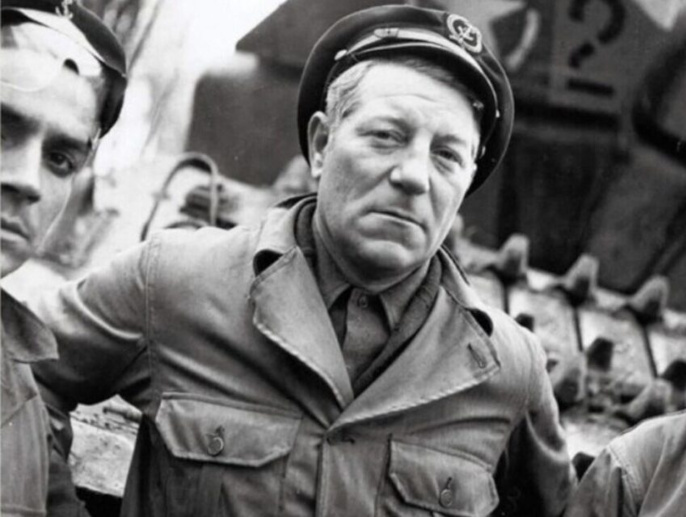
Philippe De Gaulle, son of Général Charles De Gaulle, joined the Free French Naval Forces in 1940. On 8 June 1944, he enlisted with the RBFM, where he attained the rank of Enseigne de Vaisseau (Lieutenant) and became a platoon commander in the 1er Escadron. Philippe served during the entire campaign and was lightly wounded 6 times. He continued his career in the French Navy and became Admiral in 1980. He finished his military career as Inspector General of the Navy. He was elected to the Senate and served until 2004. Another "celebrity" in the RBFM was French actor Jean Moncorgé also known as Jean Gabin. He left France for the US in 1941 but returned and enlisted with the Free French in April 1943. He then volunteered for the RBFM in January 1945 (above, left) and was the tank commander of M10 "Souffleur II" in the 2ème Escadron (part of the Groupement Tactique Warabiot with the 501ème RCC). He participated in the Royan Pocket Campaign with the 2ème Escadron in April and in the Berchtesgaden area in early May 1945. At 41 in July 1945, he was known for being the oldest tank commander of the Free French Forces. The photo above right was taken at the Château de Bouges, north of Châteauroux. The 2ème Escadron was stationed there in March 1945 before leaving for the Royan area.
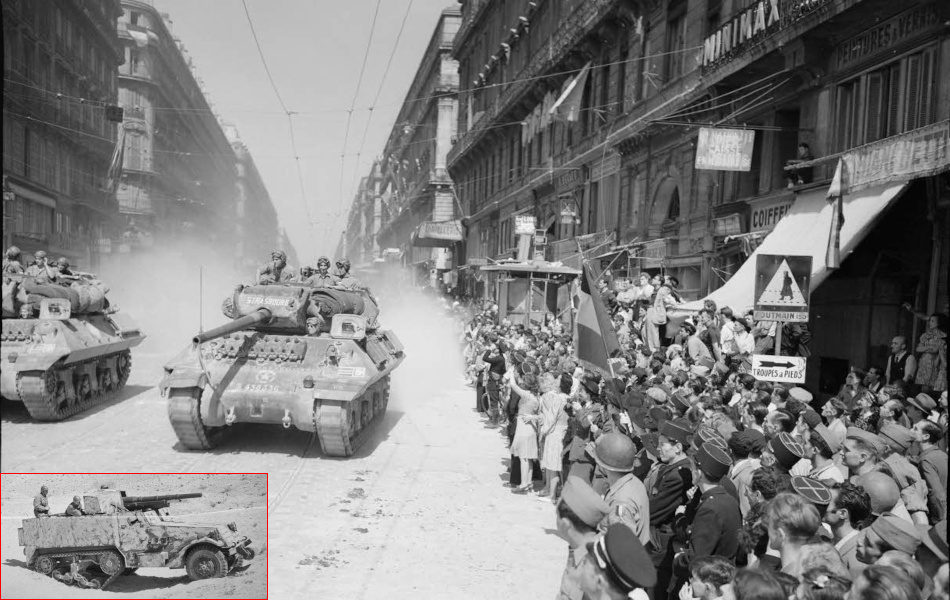
The 9ème RCA was among the first troops to land in Southern France during "Operation Dragoon". Before that, 2 detachments of the Regiment fought in Tunisia against the Germans and the Italians. One of them, led by Capitaine d'Anglejean, arrived in February, 1943 and was already equipped with "Tank Destroyers", but photos from the French archives reveal that these were M3 Gun Motor Carriages based on US Half-Tracks (inset). For the operations in France, this Regiment was part of the 1ère Division Blindée, its 3 TD Escadrons being either attached to each of the 1ère DB tank regiments, to ad-hoc combat formations or acting independently. Its 2ème Escadron landed in Sainte Maxime on 16 August, participated in the liberation of Marseille and, despite difficulties with gasoline supplies, entered Dijon on 11 September. The 3ème Escadron landed between 16 and 21 August. It entered combat on 3 September in Anse and Villefranche-sur-Saône and lost 3 TDs on that day. On 7 September, it captured a German armored train and 5 freight trains in Saint-Bérain, near Chalon-sur-Saône. Again, on 3 December, 1944, it suffered heavy casualties during German attacks on Grünhutte and Pont du Bouc, near Rixheim. The 4ème Escadron arrived a bit later and landed in France on 9 September. It entered combat on 30 September at the La Chevestraye pass, and participated in fighting in Alsace and southern Germany as part of the CC3/1ère DB. Above, M10 "Strasbourg" of the 2ème Escadron drives through Rue de la République and arrives on Quai des Belges during a liberation parade in Marseille on 29 August, 1944.
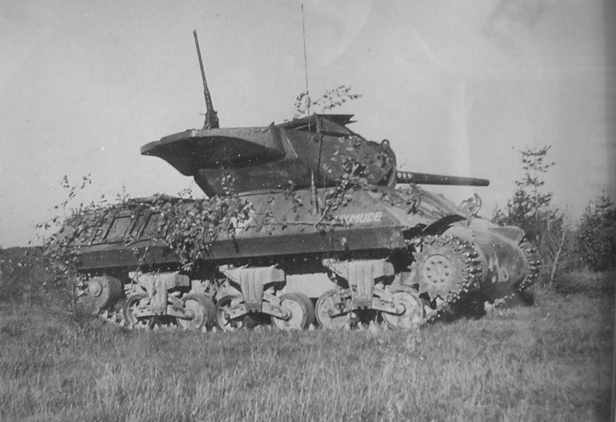
The 11ème RCA, which had transferred its 36 M10s to the Régiment Blindé de Fusiliers Marins (RBFM) in early April 1944, was issued 29 replacements on 17 May 1944 and an additional 3 on 29 June. For operations in France, the 3 TD Escadrons of the 11ème RCA were generally attached to each of the Combat Commands of the 5ème Division Blindée, but also served in ad-hoc combat formations for specific missions. The Regiment landed in Marseille in early October 1944. Its first combat mission came on 3 November 1944 and involved the 4ème Escadron in support of an attack on enemy positions at "le Haut du Tôt". The Regiment participated in the liberation of Montbeliard, Belfort, in the Alsace and Germany campaign in support of the 5ème Division Blindée, liberated Stuttgart and drove all the way to the Bregenz/Feldkirch area in Austria. Above is a photo of "Dixmude", an M10 of the 3ème Escadron damaged on 22 November 1944 in Suarce by a shell in the turret. "Dixmude" is fitted with the so-called "big turret", with a nearly vertical rear section installed with the newly designed "duckbill" counterweights, introduced in the summer of 1943. The crew appears to have added a field made armored roof to the top of the open turret.


Another French unit that was equipped with M10s was the Régiment Colonial de Chasseurs de Chars, which was activated in Morocco on 1st March 1944 as a "general reserve" unit, that is, an independent formation, available to support various French Infantry or Armor units as higher headquarters saw fit. The RCCC was partly composed of colonial troops from French West Africa and drew its M10s and other equipment in May and early June 1944. Shortly thereafter the regiment was transferred to Corsica and stationed near the 9ème Division d'Infanterie Coloniale. From there, a detachment including the 3ème Escadron was assigned to the 6ème Régiment de Tirailleurs Sénégalais (a regiment of the 9ème DIC) to support this infantry regiment and landed as part of Operation Dragoon follow up forces at La Nartelle on 20 August 1944. It was engaged at La Farlède (21 August), La-Valette-du-Var (23 August) and Toulon (24 August). The remaining units of the RCCC arrived in southern France on 22 August and the regiment was then engaged in the Doubs area, south of Montbéliard in September and near the Swiss border in October and early November, where they were mostly used as artillery. During this period, all the so-called "indigenous troops" that came from the French colonial empire were replaced with French men who had enlisted after the liberation of their cities and villages or were former members of the French Forces of the Interior [FFI, resistance fighters] inducted into the regular army. In mid-November, the RCCC was placed in support of the 1ère Division Blindée in its drive into southern Alsace that culminated in the liberation of Altkirch and Mulhouse. In January 1945, the TDs were used to support the infantry battalions of the 9ème DIC during the fighting for the suburbs and villages north and east of Mulhouse, in actions that led to the elimination of the Colmar pocket on 9 February. For operations in Germany, the RCCC was engaged in the Rhine Valley along the Schwarzwald mountain range. It liberated Karlsruhe, Rastatt and Baden-Baden. In one of its final actions, the unit reported the loss of 2 M10s on 24 April 1945 during the liberation of Lörrach, just north of the Swiss border. These screen captures come from a French Army newsreel entitled "La 9ème DIC au combat" and show "Taza II", an M10 of the 3ème Escadron that can be seen with the early "Quick Fix" counterweights on the turret. The date and location of these stills are unfortunately unknown, but in the extract, the trees have leaves so it is likely to have been filmed in April or May 1945.
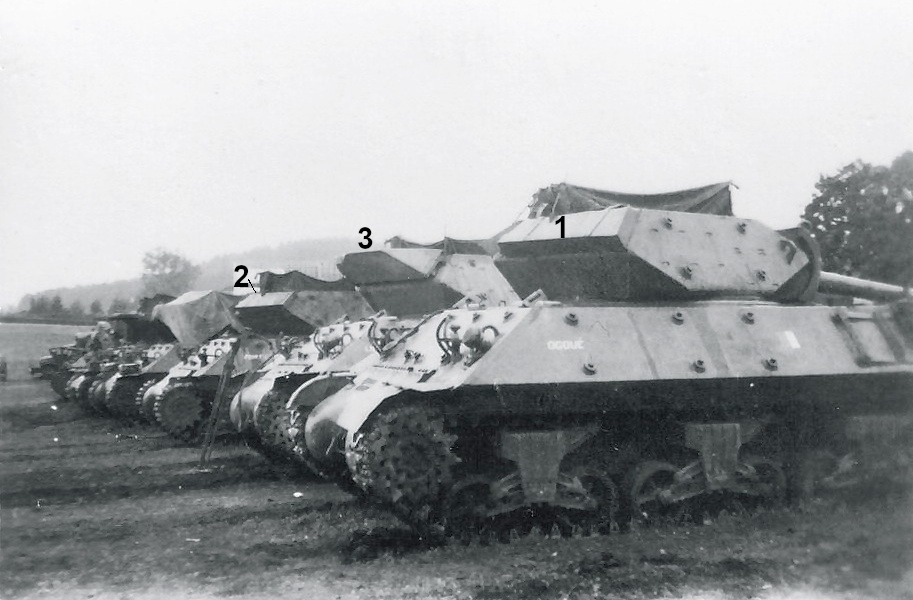
It can be seen that the RCCC was equipped with some early M10s with the improvised or "Quick Fix" counterweights (1 & 2). Note that counterweight 1 does not appear to be identical to counterweight 2. These were applied at the Chester [Pennsylvania] Tank Depot at Christmas 1942 on an expedient, "hurry up" basis to 116 M10s that were being processed for shipment to Northwest Africa. The depot used "shipyard scrap or whatever was available" to get the job done. Consequently, there was some variety to the appearance of the counterweights. After installation, the turrets were supposed to be able to track or turn without issue "on a 15-degree slope." Production counterweights (3) became available a few months later and it was ordered that "All Field vehicles should have "quick fix" counterweights replaced with production type." For whatever reason, the M10s shown here were not upgraded. The original order was intended for US Army units, so these M10s were likely "inherited" by the RCCC. It is to be noted that the 8ème and 11ème Régiments de Chasseurs d'Afrique are thought to have received at least one M10 each with the "Quick Fix" counterweights, and the 8ème RCA appears to have received at least 2 of them.
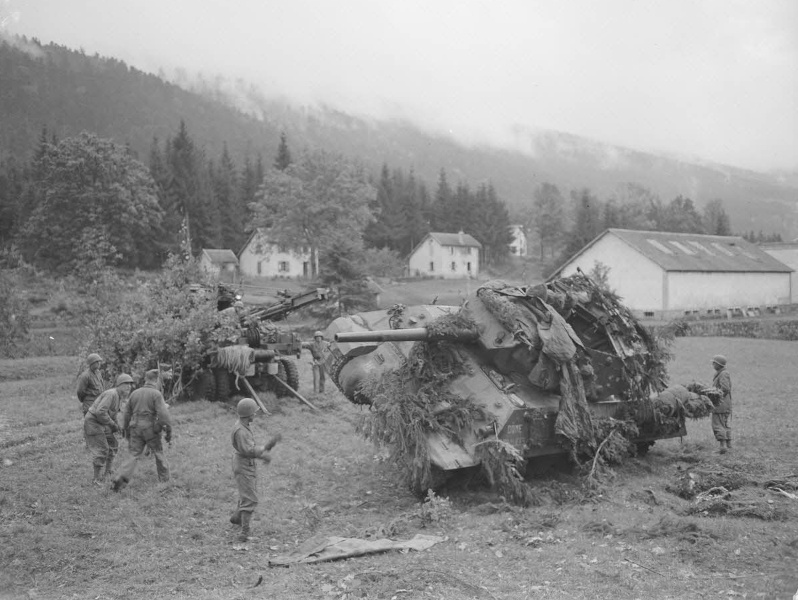
The 2ème Régiment de Dragons, which had served as part of the Vichy army since 1940, was disbanded on 29 November 1942. Nearly all the officers and enlisted men then decided to join the French Forces of the Interior [FFI] or to escape to North Africa through Spain. Nearly one year later, on 1st December 1943, the Regiment was re-created in Sfax, Tunisia from a cadre of former members. As with the RCCC, it was a "general reserve" unit, that is, an independent formation. The 2ème RD was issued 9 M10s on 3 May 1944, 9 more on 13 June, 2 more on 17 June, 6 more on 29 June and the remainder in August, bringing it up to TO&E strength of 36 M10s. The Regiment landed in Fréjus and Saint Tropez between 25 and 30 August 1944. On 2 September, the 2ème RD entered the city of Montpellier and on 9 September, liberated Autun in the Rhone valley on the western flank of the 1st French Army. In October, the Regiment supported the 3ème Division d'Infanterie Algérienne in its efforts in the Vosges Mountains in the area of La Bresse. In December, it occupied defensive positions along the Doller River and later was used as artillery against enemy positions around Cernay and north of Mulhouse. In late January and early February 1945, the Regiment fought in the battles for the workers' towns north of Mulhouse such as "Cité Else", "Cité Langenzug" and "Cité Grassegerste" and in Wittelsheim. These actions led to the elimination of the Colmar pocket. The photo above shows "Dôme des Invalides" of the 4ème Escadron being recovered by a wrecker after it overturned on an embankment in the Vosges mountains in October 1944. Image TERRE 293-6998.
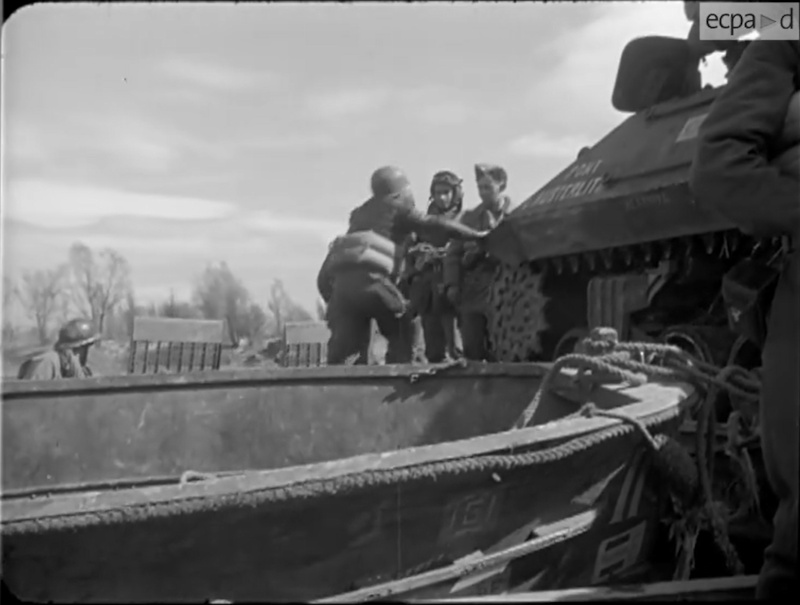
Above is a still from a video entitled "Bridgehead north of the Lauter river" that shows M10 "Pont d'Austerlitz" during Rhine River crossing operations on 1st April 1945. The 2ème Dragon's After Action Report mentions that the 4ème Escadron crossed the Rhine on rafts in Germersheim on that date and was the first French armored unit to operate on the east bank. Pont d'Austerlitz was destroyed the next day by a German anti-tank gun near the town of Graben, and two crew members were killed. In the following days, the 2ème Escadron participated in the capture of Oberkirch on 17 April, Donaueschingen on 21 April and Konstanz on 26 April. On 8 May 1945, the Regiment assumed security duties between Ludwigshafen and Unteruhldingen, along Lake Constance and the border with Switzerland.
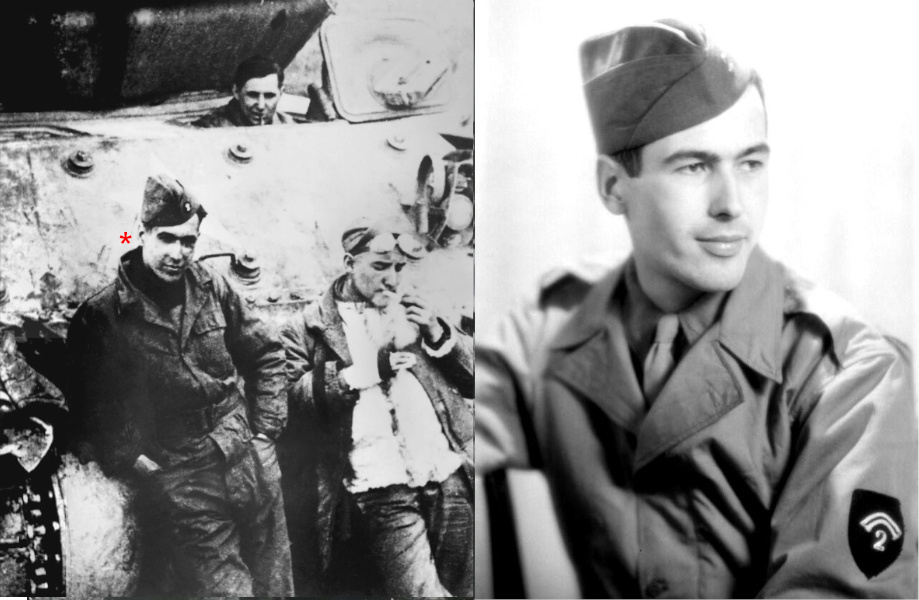
Bernard De Lattre de Tassigny was the son of Général Jean de Lattre de Tassigny, Commander of the French First Army. Bernard joined the 2ème Régiment de Dragons on 1 September 1944 at age 16. A few days later on 9 September, Bernard was wounded while attempting to deliver ammunition to an Armored Car during a firefight in Autun and was awarded the Médaille militaire for his conduct. After recuperating, Bernard rejoined the regiment on 20 February 1945. He continued to serve in the French Army and was killed in action in Indochina on 30 May 1951. Another notable of the 2ème RD was Valéry Giscard d'Estaing (above). While still a teenager, he served with a French resistance group in occupied Paris. A unit citation reads, "Brigadier [corporal] Giscard D'Estaing. Volunteered [to join the 2ème RD] at 19. Quickly becoming a first-class marksman, he demonstrated calm and composure on April 21 in Behla by directing on foot the driver of a towed tank under fire, showing complete disregard for the automatic weapons and mortars surrounding him. On April 25 [typo, April 23] at Zolhaus, his tank, having received a Panzerfaust [hit], continued to fire its cannon despite the violence of the explosion, which caused the electrical firing to break. Thanks to this immediate action, the enemy ceased its Panzerfaust fire and the tank was able to resume its mission." Some of the damage from the panzerfaust strike "which fortunately hit the headlight causing a very strong concussion, broken antenna, electric trigger no longer working" according to the AAR may be seen to the left of Giscard in the photo on the left. On 26 April, his M10 "Carrousel II" of the 2ème Escadron was the first to enter the city of Konstanz. Giscard was subsequently awarded the Croix de Guerre. "VGE" was President of France from 1974 to 1981.
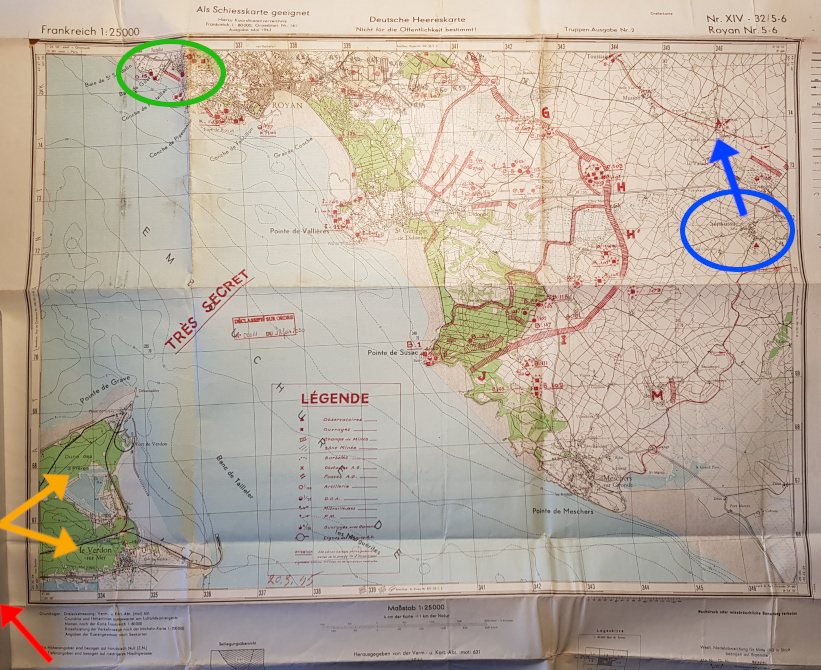
The last French regiment to receive M10s before VE-day was the 1er
Régiment de Spahis Marocains (not to be confused with the 1er Régiment
de Marche de Spahis Marocains of the 2ème DB). The Regiment was
stationed in Morocco until October 1944. It was shipped to Marseille,
unequipped, on 24 October. French and American authorities discussed
providing the 1er RSM with either M3A3 or M5 Light tanks, M8 Howitzers
or M10 Tank Destroyers. However, none of these were immediately
available and the 1er RSM was sent dismounted to the Toulouse area to
assume guard and security duties. The regiment finally received its
first 10 M10s on 24 March 1945 and allocated them to the 2ème Escadron.
It received 6 more on 2 April, which were distributed to the 4ème
Escadron. The 1er RSM participated in
the liberation of the Royan pocket, one of the "Atlantic pockets"
manned by isolated German garrisons that were commanded to hold out to
the last man in order to deny various port facilities to the Allies (inset). The
2ème and 4ème Escadron first used their M10s on 14 April 1945 in
support of an attack of the 131ème Régiment d'Infanterie when they fired
on enemy stong points in Trignac, north of Sémussac (blue arrow). On
the same day, the Regiment received 15 more M10s. On 16 April, the 2ème
Escadron supported the 131ème Régiment d'Infanterie in an attack on the
Jaffe stongpoint, just north of Royan and then helped in liberating
Pontaillac (green circle), a district of Royan. One of the TDs got stuck
in a swamp in Pontaillac, and it took several days to recover it. On 15
April, the 4ème Escadron was transferred to the la Pointe du Grave
area, on the other side of the Gironde estuary to reinforce the "Médoc"
brigade. On 18 April, it participated in an assault on Soulac-sur-Mer,
west of Le-Verdon-sur-Mer (red arrow, out of the map) and the next day,
fired from Soulac on the defenses of Le Verdon and la Pointe du Grave
(orange arrows). On the evening of 20 April, the last German positions
north of Le Verdon surrendered to the 4ème Escadron and the Médoc
brigade.

Philippe De Gaulle, son of Général Charles De Gaulle, joined the Free French Naval Forces in 1940. On 8 June 1944, he enlisted with the RBFM, where he attained the rank of Enseigne de Vaisseau (Lieutenant) and became a platoon commander in the 1er Escadron. Philippe served during the entire campaign and was lightly wounded 6 times. He continued his career in the French Navy and became Admiral in 1980. He finished his military career as Inspector General of the Navy. He was elected to the Senate and served until 2004. Another "celebrity" in the RBFM was French actor Jean Moncorgé also known as Jean Gabin. He left France for the US in 1941 but returned and enlisted with the Free French in April 1943. He then volunteered for the RBFM in January 1945 (above, left) and was the tank commander of M10 "Souffleur II" in the 2ème Escadron (part of the Groupement Tactique Warabiot with the 501ème RCC). He participated in the Royan Pocket Campaign with the 2ème Escadron in April and in the Berchtesgaden area in early May 1945. At 41 in July 1945, he was known for being the oldest tank commander of the Free French Forces. The photo above right was taken at the Château de Bouges, north of Châteauroux. The 2ème Escadron was stationed there in March 1945 before leaving for the Royan area.

The 9ème RCA was among the first troops to land in Southern France during "Operation Dragoon". Before that, 2 detachments of the Regiment fought in Tunisia against the Germans and the Italians. One of them, led by Capitaine d'Anglejean, arrived in February, 1943 and was already equipped with "Tank Destroyers", but photos from the French archives reveal that these were M3 Gun Motor Carriages based on US Half-Tracks (inset). For the operations in France, this Regiment was part of the 1ère Division Blindée, its 3 TD Escadrons being either attached to each of the 1ère DB tank regiments, to ad-hoc combat formations or acting independently. Its 2ème Escadron landed in Sainte Maxime on 16 August, participated in the liberation of Marseille and, despite difficulties with gasoline supplies, entered Dijon on 11 September. The 3ème Escadron landed between 16 and 21 August. It entered combat on 3 September in Anse and Villefranche-sur-Saône and lost 3 TDs on that day. On 7 September, it captured a German armored train and 5 freight trains in Saint-Bérain, near Chalon-sur-Saône. Again, on 3 December, 1944, it suffered heavy casualties during German attacks on Grünhutte and Pont du Bouc, near Rixheim. The 4ème Escadron arrived a bit later and landed in France on 9 September. It entered combat on 30 September at the La Chevestraye pass, and participated in fighting in Alsace and southern Germany as part of the CC3/1ère DB. Above, M10 "Strasbourg" of the 2ème Escadron drives through Rue de la République and arrives on Quai des Belges during a liberation parade in Marseille on 29 August, 1944.

The 11ème RCA, which had transferred its 36 M10s to the Régiment Blindé de Fusiliers Marins (RBFM) in early April 1944, was issued 29 replacements on 17 May 1944 and an additional 3 on 29 June. For operations in France, the 3 TD Escadrons of the 11ème RCA were generally attached to each of the Combat Commands of the 5ème Division Blindée, but also served in ad-hoc combat formations for specific missions. The Regiment landed in Marseille in early October 1944. Its first combat mission came on 3 November 1944 and involved the 4ème Escadron in support of an attack on enemy positions at "le Haut du Tôt". The Regiment participated in the liberation of Montbeliard, Belfort, in the Alsace and Germany campaign in support of the 5ème Division Blindée, liberated Stuttgart and drove all the way to the Bregenz/Feldkirch area in Austria. Above is a photo of "Dixmude", an M10 of the 3ème Escadron damaged on 22 November 1944 in Suarce by a shell in the turret. "Dixmude" is fitted with the so-called "big turret", with a nearly vertical rear section installed with the newly designed "duckbill" counterweights, introduced in the summer of 1943. The crew appears to have added a field made armored roof to the top of the open turret.


Another French unit that was equipped with M10s was the Régiment Colonial de Chasseurs de Chars, which was activated in Morocco on 1st March 1944 as a "general reserve" unit, that is, an independent formation, available to support various French Infantry or Armor units as higher headquarters saw fit. The RCCC was partly composed of colonial troops from French West Africa and drew its M10s and other equipment in May and early June 1944. Shortly thereafter the regiment was transferred to Corsica and stationed near the 9ème Division d'Infanterie Coloniale. From there, a detachment including the 3ème Escadron was assigned to the 6ème Régiment de Tirailleurs Sénégalais (a regiment of the 9ème DIC) to support this infantry regiment and landed as part of Operation Dragoon follow up forces at La Nartelle on 20 August 1944. It was engaged at La Farlède (21 August), La-Valette-du-Var (23 August) and Toulon (24 August). The remaining units of the RCCC arrived in southern France on 22 August and the regiment was then engaged in the Doubs area, south of Montbéliard in September and near the Swiss border in October and early November, where they were mostly used as artillery. During this period, all the so-called "indigenous troops" that came from the French colonial empire were replaced with French men who had enlisted after the liberation of their cities and villages or were former members of the French Forces of the Interior [FFI, resistance fighters] inducted into the regular army. In mid-November, the RCCC was placed in support of the 1ère Division Blindée in its drive into southern Alsace that culminated in the liberation of Altkirch and Mulhouse. In January 1945, the TDs were used to support the infantry battalions of the 9ème DIC during the fighting for the suburbs and villages north and east of Mulhouse, in actions that led to the elimination of the Colmar pocket on 9 February. For operations in Germany, the RCCC was engaged in the Rhine Valley along the Schwarzwald mountain range. It liberated Karlsruhe, Rastatt and Baden-Baden. In one of its final actions, the unit reported the loss of 2 M10s on 24 April 1945 during the liberation of Lörrach, just north of the Swiss border. These screen captures come from a French Army newsreel entitled "La 9ème DIC au combat" and show "Taza II", an M10 of the 3ème Escadron that can be seen with the early "Quick Fix" counterweights on the turret. The date and location of these stills are unfortunately unknown, but in the extract, the trees have leaves so it is likely to have been filmed in April or May 1945.

It can be seen that the RCCC was equipped with some early M10s with the improvised or "Quick Fix" counterweights (1 & 2). Note that counterweight 1 does not appear to be identical to counterweight 2. These were applied at the Chester [Pennsylvania] Tank Depot at Christmas 1942 on an expedient, "hurry up" basis to 116 M10s that were being processed for shipment to Northwest Africa. The depot used "shipyard scrap or whatever was available" to get the job done. Consequently, there was some variety to the appearance of the counterweights. After installation, the turrets were supposed to be able to track or turn without issue "on a 15-degree slope." Production counterweights (3) became available a few months later and it was ordered that "All Field vehicles should have "quick fix" counterweights replaced with production type." For whatever reason, the M10s shown here were not upgraded. The original order was intended for US Army units, so these M10s were likely "inherited" by the RCCC. It is to be noted that the 8ème and 11ème Régiments de Chasseurs d'Afrique are thought to have received at least one M10 each with the "Quick Fix" counterweights, and the 8ème RCA appears to have received at least 2 of them.

The 2ème Régiment de Dragons, which had served as part of the Vichy army since 1940, was disbanded on 29 November 1942. Nearly all the officers and enlisted men then decided to join the French Forces of the Interior [FFI] or to escape to North Africa through Spain. Nearly one year later, on 1st December 1943, the Regiment was re-created in Sfax, Tunisia from a cadre of former members. As with the RCCC, it was a "general reserve" unit, that is, an independent formation. The 2ème RD was issued 9 M10s on 3 May 1944, 9 more on 13 June, 2 more on 17 June, 6 more on 29 June and the remainder in August, bringing it up to TO&E strength of 36 M10s. The Regiment landed in Fréjus and Saint Tropez between 25 and 30 August 1944. On 2 September, the 2ème RD entered the city of Montpellier and on 9 September, liberated Autun in the Rhone valley on the western flank of the 1st French Army. In October, the Regiment supported the 3ème Division d'Infanterie Algérienne in its efforts in the Vosges Mountains in the area of La Bresse. In December, it occupied defensive positions along the Doller River and later was used as artillery against enemy positions around Cernay and north of Mulhouse. In late January and early February 1945, the Regiment fought in the battles for the workers' towns north of Mulhouse such as "Cité Else", "Cité Langenzug" and "Cité Grassegerste" and in Wittelsheim. These actions led to the elimination of the Colmar pocket. The photo above shows "Dôme des Invalides" of the 4ème Escadron being recovered by a wrecker after it overturned on an embankment in the Vosges mountains in October 1944. Image TERRE 293-6998.

Above is a still from a video entitled "Bridgehead north of the Lauter river" that shows M10 "Pont d'Austerlitz" during Rhine River crossing operations on 1st April 1945. The 2ème Dragon's After Action Report mentions that the 4ème Escadron crossed the Rhine on rafts in Germersheim on that date and was the first French armored unit to operate on the east bank. Pont d'Austerlitz was destroyed the next day by a German anti-tank gun near the town of Graben, and two crew members were killed. In the following days, the 2ème Escadron participated in the capture of Oberkirch on 17 April, Donaueschingen on 21 April and Konstanz on 26 April. On 8 May 1945, the Regiment assumed security duties between Ludwigshafen and Unteruhldingen, along Lake Constance and the border with Switzerland.

Bernard De Lattre de Tassigny was the son of Général Jean de Lattre de Tassigny, Commander of the French First Army. Bernard joined the 2ème Régiment de Dragons on 1 September 1944 at age 16. A few days later on 9 September, Bernard was wounded while attempting to deliver ammunition to an Armored Car during a firefight in Autun and was awarded the Médaille militaire for his conduct. After recuperating, Bernard rejoined the regiment on 20 February 1945. He continued to serve in the French Army and was killed in action in Indochina on 30 May 1951. Another notable of the 2ème RD was Valéry Giscard d'Estaing (above). While still a teenager, he served with a French resistance group in occupied Paris. A unit citation reads, "Brigadier [corporal] Giscard D'Estaing. Volunteered [to join the 2ème RD] at 19. Quickly becoming a first-class marksman, he demonstrated calm and composure on April 21 in Behla by directing on foot the driver of a towed tank under fire, showing complete disregard for the automatic weapons and mortars surrounding him. On April 25 [typo, April 23] at Zolhaus, his tank, having received a Panzerfaust [hit], continued to fire its cannon despite the violence of the explosion, which caused the electrical firing to break. Thanks to this immediate action, the enemy ceased its Panzerfaust fire and the tank was able to resume its mission." Some of the damage from the panzerfaust strike "which fortunately hit the headlight causing a very strong concussion, broken antenna, electric trigger no longer working" according to the AAR may be seen to the left of Giscard in the photo on the left. On 26 April, his M10 "Carrousel II" of the 2ème Escadron was the first to enter the city of Konstanz. Giscard was subsequently awarded the Croix de Guerre. "VGE" was President of France from 1974 to 1981.


On 27 April, the 2ème Escadron was listed with 11 TDs, the 3ème with 7 and the 4ème with 10.The 1er RSM was engaged in combat again on 30 April, 1945 as part of "Opération Jupiter", the liberation of Oléron island, north of Royan. It was not involved directly in assaulting the island, but was positioned near Thairé and Ciré d'Aunis (south of the pocket of La Rochelle) to shell the German positions and to prevent them from attacking from the north. On the 2nd of May, it supported the French infantry in taking the village of Aigrefeuille, north of Ciré d'Aunis, and the hamlets of Yves and Le Marouillet along the Atlantic coast. The 1er RSM was then sent to La Rochelle for the purpose of maintaining order in the city after the German surrender. The photo above was taken on Place de Verdun in La Rochelle on VE-Day, 8 May, 1945 during the Victory parade. The few available pictures show M10s carrying names of illustrious Spahi-related soldiers like "Général Henrys", "Général Jouinot-Gambetta" or "Sous-Lieutenant De Waziers". Another picture showing Général de Vernejoul, commander of the French Forces in Germany inspecting the 1er RSM in Germany on 29 November, 1945 shows vehicles with names of Spahi-related battles like "Uskub" or "Salonique". In late May, 1945, the regiment moved to Lahr as part of the French Forces in Germany. A document dated 29 May, 1945 states that the 36 Tank Destroyers are worn out, 2 of the Escadrons had unusable tracks which would prevent the TDs from moving.


This M10 is Serial Number 3845, a vehicle built by Fisher in July, 1943. The corresponding USA number is 4082060. It is currently in a private collection in France and has been restored to running condition. The After Action Report of the 1er Régiment de Spahis Marocains lists USA 4082060 as having been allocated to the 2ème Escadron, 1er RSM on 24 March, 1945. It also lists the Registration Numbers of 15 more M10s received on 24 March and 4 April, 1945 and it shows that these vehicles were produced between December 1942 and September 1943. At least one of them has been identified with the 818th Tank Destroyer Battalion in the UK, in March 1944. This American TD Battalion was converted to M36s in February 1945 and probably transferred some of its surplus M10s to the French after conversion.
The list of French Sherman tanks, M10s, M7s and TRVs during WW2
HOME